
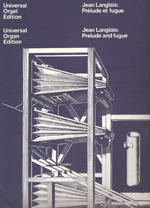
1927
Prelude and fugue
With this "Prelude and fugue" for organ, Jean Langlais, aged 20, won the first Composition Prize at the Paris National Institution for the Blind in 1927. This work, on a given theme by his teacher André Marchal, will be published only 55 years after it has been composed, by Universal Edition (Wien) in 1982, and dedicated to one of his pupil just issued from the Paris Conservatoire with a First Prize in the organ class.
Editions Universal (Site web)
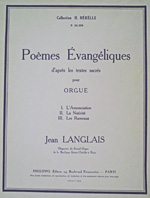
1932
Poèmes Evangéliques
I. L'Annonciation - II. La Nativité - III. Les Rameaux
Published in 1933 par Hérelle (France).
Available also on the website sheetmusicplus.com
CORRECTED ERRORS in the score.
II - LA NATIVITE
No errors for the notes, but tempi added from Langlais'recording at Sainte-Clotilde in 1976 (Solstice SOCD 1)
LA CRECHE: dotted quarter note= 40
LES ANGES: half note= 66
LES BERGERS: quarter note= 66
LA SAINTE FAMILLE: quarter note= 66
At the end of the piece, p.11, bar 14, tempo primo,:like the beginning of the piece: dotted quarter note= 40
III - LES RAMEAUX
p.12, mes. 15, left hand : add a pause of a quarter
Editions Henry Lemoine (Site web)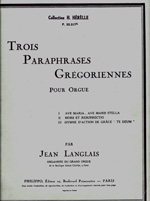
1933-34
Trois Paraphrases Grégoriennes
I. Ave Maria, Ave Maris stella - II. Mors et Resurrectio - III. Te Deum
Published in 1934 by Hérelle (France).
CORRECTED ERRORS in the score.
I - AVE MARIA, AVE MARIS STELLA - Tempo, Lento: quarter = 69 and not 58 (tempi taken from Jean Langlais recording at Ste Clotilde in 1960- ERATO LDE 3049, "Oeuvres pour orgue d'inspiration grégorienne"
p.4, tempo, quarter =76 // p.4, mes. 3, left hand, tie the c doted quarter to c quarter
p.6, mes. 5, Piu vivo, quarter=112 // p.6, mes.11, right hand goes to Récit on the last note, f#; tie last two d# in left hand on GO; alto part moves to Récit on beat 1, mes.12.
p.7, mes.2, Tempo, quarter= 112 // p.7, mes.9, A tempo, noire= 69
II - MORS ET RESURRECTIO - Tempo, Andante, quarter = 63
p.9, mes. 1, pedal, add natural to f. // p.9, mes. 9, right hand, beat 2, add natural to c.
p.10, mes. 18, left hand, beat 3, add # to c.
III - HYMNE D'ACTIONS DE GRACE "TE DEUM" - Metronomic indications: p.13, Maestoso, quarter=88, p.15, a Tempo, dotted quarter=108, p.16, Un poco pie vivo, doted quarter=116, p.18, Maestoso, quarter=72, Allegro, quarter=138 and not 80
p.13, mes.6, right hand, beat 1, add first leger line; beat 3, # belongs to g. // p.13, mes.7, l.h.beats 2-3, tie a quarter to a half.
p.14, mes. 1-2, l.h. 3rd beat tied to 4rth beat, omit lowest note e in the chord // p.14, mes.8, l.h.beat 3, # belongs to a. // p.14, mes.10-11, r.h., beats 2-3, tie a# // p.14, mes.13, 1rst beat, r.h. c# is dotted quarter, like l.h.
p.16, mes. 8 and 10, r.h., beat 4 should repeat beat 3, 2 doted quarter and not doted half note on beat 3.
p.17, last mes. pedal should be detached on c# and d natural.
p.18, mes. 1, The Tutti comes here, not at mes.2. // p.18, last mes.,right hand, the first chord should be f#-g#-b natural
p.19, mes.4, l.h., beat 1, top# belongs to g, not b. // p.19, mes. 4, l.h. beat 3-4, omit lowest note e in the chord, as p.14, mes. 1-2 left hand. // p.19, mes.12, pedal e, tie sixteenth to eighth.
The tempi corrected are taken from Jean Langlais' first recording of his "Te Deum" at the organ of Sainte-Clotilde in 1955.
The mp3 of it can be sent for free on demand to: ml.langlais@wanadoo.fr
Editions Henry Lemoine (Site web)
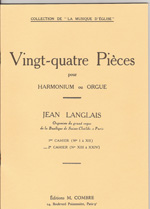
1934-1936
Vingt-Quatre Pièces pour harmonium ou orgue
1er Cahier (n°1 to XII) published by Hérelle (France) - 1939- , also available on the website sheetmusicplus.com
1. Prélude modal - 2. Hommage - 3. Arabesque - 4. Fugue - 5. Paraphrase sur "Salve Regina" - 6. Noël avec variations - 7. Choral - 8. Ricercare - 9. Scherzetto - 10. Toccata - 11. Prière pour les morts - 12. Hommage à Fr.Landino
"24 Pieces for harmonium! It is a symbolic number like that of a dozen oysters, not 22 not 25 nor 23 or the house crumbles! Franck had already covered this long trail, sometimes, one must admit, a little bit too quicky. You shall reach your objective, dear friend, and, I hope you will be well rewarded for your efforts on behalf of this strange instrument for which, in my opinion, you composed for with your heart and soul, the droning timbre of said instrument strangely affects the spine. I am sure that you shall find a way to ennoble its too easy mystic character..." Paul DUKAS, letter to Jean Langlais, september 7, 1934
CORRECTED ERRORS in the PRINTED SCORE
1 - PRELUDE MODAL: p.1, bar 10, 1rst beat, the indication R (Swell) is on the E, not later, like bar. 2, p.2
p.2, bar 3-4, Bflat right hand has to be tied to the F#, alto, following bar // p. 2, bar 7, add rall. at the end of the bar // p. 2, bar 8, the first a# right hand, is a quarter note.
Tempo recommended for the organ: Andante, quarter note= 50
2 - HOMMAGE: p.3, bar 2-3, left hand, the G whole note is tied to the following bar // bar 6, the D, whole note, is natural for both hands // p.3, bars 17 and 21, the stops changes are for the 1rst beat.
p.4, bar 15, 3rd beat, the # is on the C, not on the D.
Tempi recommended for the organ: Piu vivo, bar 11, quarter= 77;
Bar 17, Tempo primo, quarter= 46; bar 21, Piu vivo, quarter= 77.
3 - ARABESQUE: p.6, bar 14, left hand, C# should be tied to the C# next bar // p.6, bars 21-22, left hand, the legato sign is for the
G# , not for the F.
p.7, bars 21-22, Connect the F, left hand, 4th beat, with the upper F of the next chord, right hand.
Tempi recommended for the organ: Andantino, quarter,= 68. Piu vivo, quarter doted= 75
4 - FUGUE: p.8, bar 16, 3rd beat, alto, the C# has to be tied to the C# 1rst beat bar 17 // p.8, bar 18, right hand, 2nd beat, the rest is not a quarter rest but a eighth rest. The eighth rest is lacking, alto part, beat 3 // p.8, bar 24, left hand, the 3rd eighth note should be a B, not a G#.
p.9, bar 18-19, a quarter rest is lacking on the 2nd beat.
p.10, bar 21, fist beat, right hand, G#, quarter note, is lacking. It is tied with the preceding G#. The sign legato is not between G# and E as indicated.
Tempo recommended for the organ, Andante, quarter= 67.
6 - NOEL AVEC VARIATIONS: p.13, tempo, doted quarter note=65, not 58. 3rd Variation, p.16, tempo: quarter note= 72 (not 58). Coda, p.17, tempo, doted quarter= 65, not 58.
7 - CHORAL: p.18, tempo, Maestoso, quarter note= 69, not 52 // Variation I: Adagio, quarter= 51, not 42.
p. 19, Variation II, Andante, quarter= 100, not 66 // p.19, bar 14, soprano, add a eighth rest to the chord, like bars 4, 8 and 11.
p.20, Variation III, Allegro, tempo: quarter note= 106, not 88.
10 - TOCCATA, p.12, tempo, quarter note= 61, not 56 // p.12, bar 8, the indication G.O. mf is lacking.
Editions Henry Lemoine (Site web)

1936-1939
Vingt-Quatre Pièces pour harmonium ou orgue
2e Cahier (n°XIII to XXIV) - published by Hérelle (France) in 1942, also available on the website sheetmusicplus.com
13. Homo quidam - 14. Allegro - 15. Prière - 16. Choral orné - 17. Pour une Sainte de Légende - 18. Fantaisie sur un thème Norvégien - 19. Prélude - 20. Fuguette - 21. Fantaisie - 22. Chant élégiaque - 23. Point d'Orgue - 24. Impromptu
CORRECTED ERRORS in the EDITION
13 - HOMO QUIDAM
p.2, bar 5, right hand, C# should be quarter. Triplets are lacking in all the page, either right hand or left hand // p.2, bar 12, left hand remains on the Swell.
p.3, last line, bar 2, left hand, delete mark under tied F#.
16 - CHORAL ORNé
p.11, last line, bar 5, cut the soprano ligne between G, half note, and A flat, eighth note.
17 - POUR UNE SAINTE DE LEGENDE
Tempo, Andante, doted quarter= 48
21 - FANTAISIE
p.24, bar 4, beat 1, add tie to D //p.24, bar 16, 2nd beat, the E left hand should be a E#, like in the following mes.2e temps,
Editions Henry Lemoine (Site web)
1939
"L'Orgue, l'Improvisation et la Composition musicale enseignés à des élèves aveugles par un professeur aveugle"
Mémoire to obtain the title of Music Teacher at the National Institution for the Blind in Paris
"Teaching Organ, Improvisation and Composition to blind pupils by a blind teacher". This 54 pages' taped text is unpublished.
In French.
Collection Marie-Louise Langlais
Unpublished work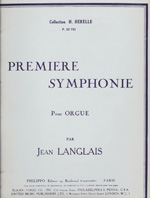
1941
Première Symphonie
Allegro - Eglogue - Choral - Final
Published by Hérelle (France) in 1945.
Available also on the website sheetmusicplus.com
Unfortunately, there are numerous errors in the published Hérelle edition of this work, so here is a list with the help of Kathleen Thomerson, Jean-Baptiste Courtois who played the work to Jean Langlais, and of Jonathan Moyer who plays often this piece.
ERRORS IN THE SCORE PUBLISHED BY HERELLE
1 - ALLEGRO
p.2, m.3 and 7, 2nd beat, right hand, off the low F quarter note. p.4, m.3, pedal E should be half note //p.4, m.4, beat 1, left hand, the chord is a natural-d natural (not c)-f #-g# // p.4, m.4, beat 1, left hand, add dot to g# // p.4, m.6, left hand, the chord is an eight note with an eight note rest, and the last chord, left hand, is tied to the following one of the next measure // p.4, mes.8, left hand, 1rst beat, the a is tied to the second beat, like the c.
p.7, m.13 and 14, 1rst beat, right hand, the chord is a sixteen note, not an eight note.
p.8, m.5, left hand, beat 3, add flags to make eighth notes // p.8, m.5, 32th notes staccato, like the right hand // p.8, m.121, right hand, add dot to c#; beat 2, right hand, add dot to e // p.8, m.14, pedal legato.
p.9, m.7, right hand should use sataccato marks as in previous and following measures. No change of touch is intended // p. 9, m. 18, left hand, the b of the chord is flat.
p. 10, m.7-11, left hand and pedal, all notes staccato.
p.11, m.5, left hand, same alterations than the preceding measures, with a b natural on the first beat and a b flat on the second.
p.12, m.6, left hand, the last chord is b natural-f#-a# (not b#) // p.12, mes.18, left hand, 2nd beat, the first sixteen notes are c#-f#, not c#-g# // last measure, semipro staccato does not apply to the pedal.
p.13, m.1, right hand, last beat, the chord is a flat-d flat // p.13,m. 13, pedal legato.
p.15, m.8, right hand, on the third beat, same chord than on the first, the b flat is lacking // p.15 m.11, left hand, beat 1, add # to f, like at the right had. // p.15, m.14, pedal should be as at m.7, cancel the rest // p.15, last measure, left hand the last three sixteen notes are : b natural-a natural- a flat.
p.16, m.7, the signature is 4/8, not 5/8.
2 - EGLOGUE
p.19, m.12, right hand, beat 3, add dot to e.
p.20, m.5, "Plus Lent", quarter note = 72 // p.20, m.12, right hand, beat 3, add dot to a#.
p.22, m.5, right hand, 4th beat, the small note is c natural // p.22, m. 9, "Plus vif", quarter note = 100
p.24, m.2, left hand, beat 3, add dot to d# // p.24, m.7 and 8, left hand, the# belongs to g // p.24, m.10, left hand beat 3, add # to d.
3 - CHORAL
p.25, tempo quarter note= 60 and not 52, much too slow.
p.26, m.2, slow down at the end of the bar // p.26, m.4, "Plus Vite"
(faster) // p.26, m.6, first beat, left hand, the f is an e, not a f, tied to the e of the preceding bar.
p.27, m.2, left hand, manuals must be inverted : The f, half note doted has to be played on the Great and the g, tied with the preceding g, has to be played on the swell // p.27, letter D, add a respiration after each voice, like on bar C // p.27, registration should be : soprano, cornet on the swell, 2nd soprano on the IVth manual with flute 8, Ped flute 8, Positif cromorne 8 and basse, left hand, soft 8 and 4 of the GO.
p.28, 3rd m. of the "Plus Lent", right hand, the chord is b flat-d natural and not b flat e natural.
4 - FINAL
p.30, m.4, right hand, 2nd eight note, e# and not e natural.
p.37, M.8, 3rd beat left hand , the a in the chord is natural // p.37, m.15, left hand, the chord should have 4 notes : e-f#-a-c
p.39, m.4, the dynamic marking "p" should begin on the first beat // p.39, rm.4, right hand, 3rd beat, top voice is a triplet, so b should be lined up with g# // p.39, m.8, 2nd chord left hand should be played on the 3rd beat, together with the pedal c // p.39, m.9, left hand, 2nd chord is eight note tied to a doted quarter note.
p.40, last mesure, second beat right hand, the triplet begins with a c, not an a (like preceding measure).
p.42, m.13 and 14, left hand, last chord, the chord is b flat, d natural and f natural.
p.44, m.17, pedal and right hand, the 2 last chords are triple eight notes, not sixteen.
Editions Henry Lemoine (Site web)
1942-43
Neuf Pièces
I.Chant de peine - II. Chant de joie - III.Chant de paix - IV.Chant héroïque - V.In dulci jubilo - VI.De profundis - VII.Mon ame cherche une fin paisible - VIII.Prélude sur une antienne - IX.Rhapsodie grégorienne
First published by Bornemann (France) in 1945. About 40 years later, in 1983, Jean Langlais completely modified the "Rhapsodie grégorienne" (n°9), and corrected most of the mistakes of the first edition.
CORRECTED ERRORS in the EDITION
II - CHANT DE JOIE (Song of joy)
p.4, bar 4, right hand, beat 3, add natural to d // p.4, bar 6, beat 3, tie f to beat 4.
p.7, bar 3, left hand, second sixteenth of beat 3, add sharps to c and a // p.7, bar 4, right hand, cancel # on d // p.7, bar 4, left hand the natural sign is on the d, not on the a/ / p.7, bar 4, right hand, beat 4, add b to A and, last note, A natural // p.7, bar 16, left hand, the chord is F#-G#-B and not F#-G#-A, like in the preceding and the following bars.
III - CHANT DE PAIX (Song of peace)
p.9, bar 13, - flûte 4, + tirasse Positif and not Flute 4 solo// p.9, last bar, pedal: - Pos/Ped + Bourdons 16,8. // p.9, the last 3 bars (Plus lent), both hands play on the Swell, and the Swell box close on a pianissimo at the end.
IV - CHANT HEROIQUE
p.16, bar 8, add tie and dot to pedal C.
p.17, bar 1, right hand add ties between d, g, c chord, like the left hand.
p.19, bar 7, right hand, 2nd beat, the chord C-E is not staccato // slow down before the last chord of the piece.
V - DANS UNE DOUCE JOIE
p.20, bar 7, beat 1, the pedal F# should be a half note.
VI - DE PROFUNDIS
p.25, bar 7, English registration should be at the Repeat:" off Swell reeds and mixtures"
p.26, bar 2, left hand, add # to the D // p.26, bar 4, left hand, add # to the 2nd F of the measure, like in the preceding bar.
VII - MON AME CHERCHE UNE FIN PAISIBLE
p.29, bar 7, cut between 3rd and 4th beats, hands and pedal // p.29, bar 8, alto right hand, E tied to the next and D also.
VIII - RGAPSODIE GREGORIENNE
Jean Langlais has modified drastically this piece in March 1980, 35 years after its publication by Bornemann.
Here are the changes made:
p.32 to 38 bar 5 (in the first edition, p.37 in the second edition), nothing changes. But p.38, bar 6 (p.37, bar 6 in the first one), the music changes completely. In place of the "Lauda Sion", Langlais cancels 17 bars of the first version and goes directly to the "Large" (p.39 in the first version, p.37 in the second). Then nothing changes for the next 36 bars. The main difference between the two versions comes p. 37 (p.42 in the first version) in the Toccata following. The composer writes a completely new version (Large et Solennel, end of page 39) which shows a superposition of 2 themes ("Lauda Sion" followed by "Verbum supernum, right hand, with "Sacris solemniis" at the pedal), a toccata figure he used to improvise at the end of the Mass or of a concert. P. 43, bar 2, a natural sign is lacking before the G, in the chords right hand and left hand; same thing, p.43, bar 3, the natural sign has to be placed left hand before the F and not the D.
Same place, p.43, bar 3, right hand, the second chord is a half note and a half sigh, like bar 2, 4 and 5.
The last page (p.46, bars 5 to 15 first version, and p. 43, bars 2 to 12, version of 1980) is the same in both versions.
Having made such big cuts and changes, Jean Langlais wanted to pay homage in a more complex way to his master Charles Tournemire to whom this final piece of his "Neuf Pièces" has been dedicated.
Editions partitions-musicales.net (Site web)
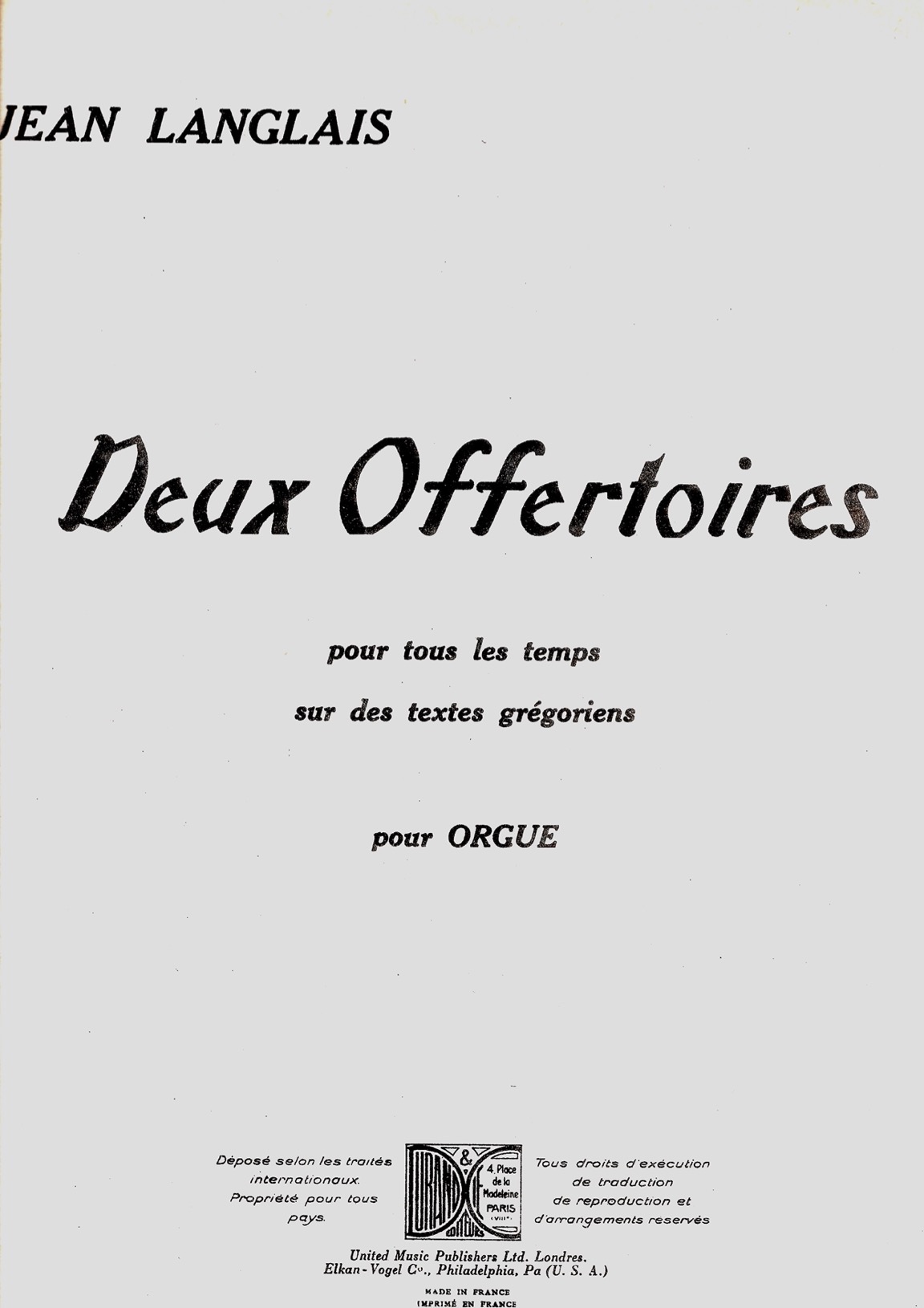
1943
Deux Offertoires pour tous les temps sur des textes grégoriens, pour orgue
I - Paraphrase de la messe "Stelliferi conditor orbis" - II - Paraphrase de la messe "Magnae Deus potentiae"
Published by Durand in 1943.
Also available on the website sheetmusicplus.com
A recording of the first Offertoire by Jean Langlais at Sainte-Clotilde, in 1960, with the chants sung by the Choir René Malherbe is available on YouTube (BNF Collection).
Editions stretta books (Site web)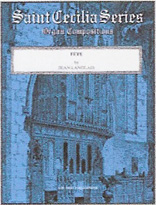
1946
Fête (reprint)
again available
First published by Gray (USA) in 1949 and a longtime unavailable, "Fête" is back again by popular demand for a new generation of organists. On the AGO National Performance list (USA).
CORRECTION of PRINTED ERRORS published by H.W.Gray (St Cecilia Series n°884-885, 1949, reprint by Alfred Music publishing)
p.10, measure 1: left hand, beat 3, 3rd sixteen C#, not D, like in the following measure.
Editions Alfred Music (Site web)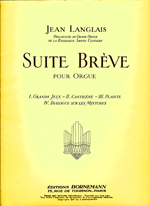
1947
Suite Brève
I. Grands Jeux - II.Cantilène - III. Plainte - IV. Dialogue sur les mixtures
Published in 1947 by Bornemann (France).
Available also on sheetmusicplus.com
ERRORS CORRECTED in the PUBLISHED SCORE
1 - GRANDS JEUX: Tempo, Maestoso: Quarter note= 66, not 54// p.1, last chord of the page, both hands, chord A natural- C# - F natural - A natural.
p.2, bar 1, both hands, the # is before the C, not the D.// p.2, bar 3 right hand, chord A natural (not #) - D natural-E // p.2 bar 13, legato // p.2, bars 14-18, articulations as in p.1, bars 15-16, staccato right hand and slurs left hand.
p.3, bar 2, the chord right hand is a half note, not a whole note // p.3, bar 7, pedal, 2nd beat, the F natural half note is tied to the F following bar // p.3, bar 13, 2nd beat left hand, the chord is C#- E natural- A.
p.4, bar 7, right hand, beat 3, add natural to C1.// p.4, bar 11, ped., a D 3rd line is missing; it should be an octave like 2 bars later with the C#.// p.4, the penultimate chord is, for both hands, G natural- A#- D#- f#-G natural.
2 - CANTILENE: p.5, bar 3, the 2 B should be connected right hand // same thing 11 and 12 with the C# and the B, right hand.
p.6, bar 8, left hand, the B is a half note, not a whole note // p.6, bar 10, right hand, first beat, the G is # // p.6, bar 12, 1rst beat left hand, the C is a half note, not a whole note.
p.8, bar 9, left hand, 3rd beat, the G is natural, in the chord.
p.9, bar 10, right hand, 4th beat, the second sixteenth is a D natural // p.9, bar 11, 2nd beat right hand, the first sixteenth is a D# // p.9, bar 11, all at the end of the measure.
3 - PLAINTE: p.10, add the trémolo to the Bourdon 8 and Vox humana of the Swell.
p.11, bar 2, pedal, the 3rd note is E flat, like bar 6, p. 10 //p.11, bar 4, off the tremolo // p.11, bar 18, delete leger line above left hand chord.
4 - DIALOGUE SUR LES MIXTURE: p. 13, bar 12, 1rst sixteenth right hand is a A natural.
Editions di Arezzo (Site web)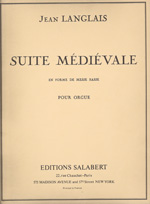
1947
Suite Médiévale en forme de messe basse
I. Prélude (Entrée) - II. Tiento (Offfertoire)- III. Improvisation (Elévation) - IV. Méditation (Communion) - V. Acclamations (sur le texte des Acclamations Carolingiennes)
Published in 1950 by éditions Salabert (France)
CORRECTED ERRORS in the printed score
I - PRELUDE ___ p.3, mes.20 and p.4, mes. 1 to 4, left hand, remove dot from half note g . Same place, bars 20 to 24, all F# have to be doted.
p.4, mes. 5, both hands on the Great // p.4, mes.11: right hand stays on the Swell, left hand goes to the Great.
II - TIENTO ___ p.5, m.7: Slow down on the last beat, before the pedal entrance, like at the end of mes. 12, on the pedal solo, and p.7, beat 1, at the end of the pedal solo. // p.6, mes.12, first beat, cut the pedal part between B and the following E // p.6, mes. 13, the quaver rest at the hands is unnecessary.
p.7, mes. 12, the indication Fl 4 solo on the pedal is for the beginning of the next measure.
III - IMPROVISATION ___ p.8, mes. 7: the D is a half note, not a quarter, like at the r.h..,
p.8 PIU LENTO, last measure, r.h. soprano part; the D is tied with the preceding one, like at the l.h.
IV - MEDITATION ___ p.11, mes. 4: the registration for the Gregorian theme, left hand, is, as written in the score, Bourdon 16, soft flute 4, a color he used often in his music and improvisations// p.11, mes.7, first beat r.h.soprano E-F# and not F natural, like the preceding measures. // p.11, mes.11, l.h., 1rst and 2nd notes at the top voice not two G# but G#-A# for a 2nd chord C#-F natural-A# and not G#.
p.12, last measure, beat 3, add leger line to make C.
p.13, last measure, add tied G whole note to r.h.chord, like l.h.chord.
V - ACCLAMATIONS (sur le texte des acclamations carolingiennes) ___ p.14, mes.7, wrong rhythm at the soprano r.h., it should be 2 sixteenth tied to a quarter note and to a doted quarter.
p.15, mes.12, r.h., 1rst beat, G is natural and F#// p.15, mes.18, r.h., soprano, the doted E must be tied to the preceding one. Same thing mes. 20 with the soprano F//
p.17, mes.14, the r.h.chord can be red fa#-G natural-B-E or F natural, G#-B-E like l.h. Jean Langlais used to say, humoristically, that he liked dissonance and that both solutions were possible, up to you. // p. 17, last mes. off the Gr to Ped. Put it again p.18, mes.9
p. 18, mes. 11, right hand, 1rst beat, the chord is E natural-G#-Bb-C# // p.18, mes. 28 and 29, soprano right hand, the tied doted quarters are on the G, not on C and D.
p.19, mes. 12-13, m.d. soprano, the octave C-C is tied to the following measure., // p.19, mes. 18, the natural G, r.h. is tied to the following one, mes. 19, like l.h. // p.19, mes. 24, the natural G, r.h., is tied to the following one, mes. 25, like l.h.
Editions la flute de pan (Site web)
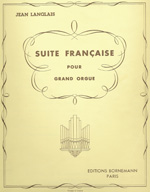
1948
Suite Française
I.Prélude sur les grands jeux - 2.Nazard - 3.Contrepoint sur des jeux d'anches - 4.Française - 5.Choral sur la voix humaine - 6.Arabesque sur les flûtes - 7.Méditation sur les jeux de fonds - 8.Trio - 9.Voix céleste -10. Final rhapsodique
Published in 1948 by Bornemann (France).
CORRECTIONS of the PRINTED ERRORS in the EDITION
I - PRELUDE SUR LES GRANDS JEUX
p.1, bar 7, beat 4 right hand, the chord is staccato like in bar 6.
p. 4, bar 10, right hand, 3rd beat, the B in the chord is flat.
II - NAZARD
p.9, mes. 12, The last note, right hand, is an eight note, not a quarter // p.9, measure 13, left hand, tie g# to a of mes. 14
p.11, measure 2, add Rit. on beat 3, and a tempo 1rst beat mes. 3.
IV - FRANCAISE
p.15, mes. 10, left hand, tenor, after 3rd beat: E flat and not F.
VI - ARABESQUE SUR LES FLUTES
p.23, mes. 12, right hand on the Positif, left hand on the Swell
p.24, mes. 1, the soprano E, fourth beat, is natural // p.24, mes. 2, pedal, unnecessary tie between beats 2 and 3.
p.25, bar 8, left hand, the E first beat is tied to the E bar 9.
p.26, bar 3, left hand, the D are natural.
IX - VOIX CELESTE
p.34, mes. 3, left hand, tie c# to d flat of mes. 4.
p.36, mes. 17, left hand, first beat is E#
p.37, mes. 1, idem tie left hand D to first D of measure 2.
X - FINAL RHAPSODIQUE
p.40, mes. 11, add leggier line to make C on second sixteenth of beat 3.
Editions stretta books (Site web)
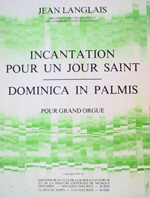
1949-1954
Incantation pour un jour Saint
Available also on the website sheetmusicplus.com
Published by "Les éditions de la Schola Cantorum" in 1954 in the collection "Orgue et Liturgie n°1, "Pâques", then published again in 1980 by the same publisher, solo and also in a volume along with "Dominica in palmis" (p. 2 to 7)
CORRECTED ERRORS in "Incantation pour un jour Saint" . For the errors in "Dominica in palms" see further, in 1964.
p.2, mes.1,3,5,the octaves, right and left hands, are potato, like the pedal mes.2, 4, 6.// p.2, mes. 2, soprano, first beat, chord values are whole note - half note - whole note, as they should be mes. 4. // p.2, mes. 10, the 3 chords, left hand, are portato.
p.3, mes. 9, the indication GPR Anches is wrong, no reeds there, only G.P.R
p.4, mes. 2, right hand, the first a is a quarter note, not a eighth note, like in the 3 following measures // p.4, mes. 2, last chord left hand is c#-e#, like in the 3 following measures. // p.4, mes. 10, pedal, beat 2, add # to C // p.4, mes 10, right hand, beat 3, a natural, not #. // p.4, mes. 10, the value of the c# chord, for all parts, is dotted quarter notes everywhere, with a fermata, and an eight rest at the end of the mes. // p.4, last measure, left hand, beat 4, add leger line below chord to make printed notes e-g.
p.5, mes. 13, last beat, soprano right hand, the g is natural, like in the 3 previous mes. // p.5., mes. 15-16, soprano D is tied with soprano E flat.
p.6, mes. 2, last beat, right hand, soprano f, sixteen, is tied to f, eight . // p.6, mes. 2, 2nd beat, 4th chord right hand, the D is natural not #. // p.6, same thing mes. 5 and 9 with the D, natural.
p.7, mes.3, 2nd beat, 3rd chord right hand not dotted. // p.7, mes. 7, the sixteenth are a#-b#-c#, not b natural // p.7 mes. 10, left hand, add a dot after the g natural // p.7, mes. 12, the first b, first chord left hand, is a b natural. // p.7, mes. 13, left hand , first beat, off the first B and replace it by the following 4 sixteenths: B-C#-B-A# then B half note // p.7, mes. 14-15, big breath before the last D chord.
Editions stretta books (Site web)
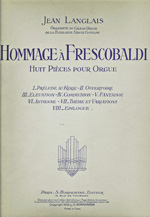
1951
Hommage à Frescobaldi
I. Prélude au Kyrie - II. Offertoire - III. Elévation - IV. Communion - V. Fantaisie - VI. Antienne - VII. Thème et variations - VIII. Epilogue pour pédale solo
Published by Bornemann (France) in 1952.
Also available on the website sheetmusicplus.com.
ERRORS CORRECTED in the PRINTED SCORE
II - OFFERTOIRE -
p.4, last measure: r.h., beat 3, add natural to D (precaution)
p.6, mes. 5: l.h., beat 2, G is #, not natural
III - ELEVATION - p. 7, mes.11: l.h. chord ties to mes. 12, as mes. 14 to 15 and 15 to 16.
p.8, mes. 12: left hand, beat 1 should be e natural-a.
IV - COMMUNION - p.12, m.8 and 9: pedal, D#-A#, right foot, should be played one octave higher // p.12, m.12: registration should be - nazard (sign - is lacking) // p.12, mes. 13: right hand on the Great // p.12, m.16: the flat belongs to B, tied to the preceding
B flat
V - FANTAISIE - all time legato, nothing staccato except when it is indicated, p. 17
p.14, mes.1-2: play on Swell, box closing at mes.2 // p.14, last measure: right hand,3rd beat, add natural to e
p.16, mes. 3: last chord time value is wrong; should be dotted eighth tied to quarter. // p.16, mes.8, Rall. // p.16, last measure of the page: the sign Rall should be situated on the next page, 2nd beat of measure 1.
p.17, 16: the 3 first chords should be "portato"
VII - THEME ET VARIATIons - The piece has to be played legato, except when it is indicated staccato.
p.22, mes.2, beat 1, soprano, the B is flat, not natural
p.24, mes. 14 and 16, it is easier to invert the hands, begin with the right, then the left on beat 3 and the last triplet on the left.
p.26, mes. 18, 2nd beat, soprano, the G is a eighth, not a quarter.
EPILOGUE
p.27, mes. 10, a rest is lacking on the D natural beat 3. // p.27, mes. 14 and 15, the last eighth should be staccato // p.27, mes. 16, 3rd beat, the G should be natural.
p.28, mes. 1, beat 3, the fourth sixteen should be a B natural //p.28, mes. 15: on beat 3, the second sixteen should be natural
p.29, mes. 13: tirs sixteen is a B natural and the G has to be flat.
p.30, mes. 3: add a fermata on the rest in both feet.
Editions musicroom.com (Site web)
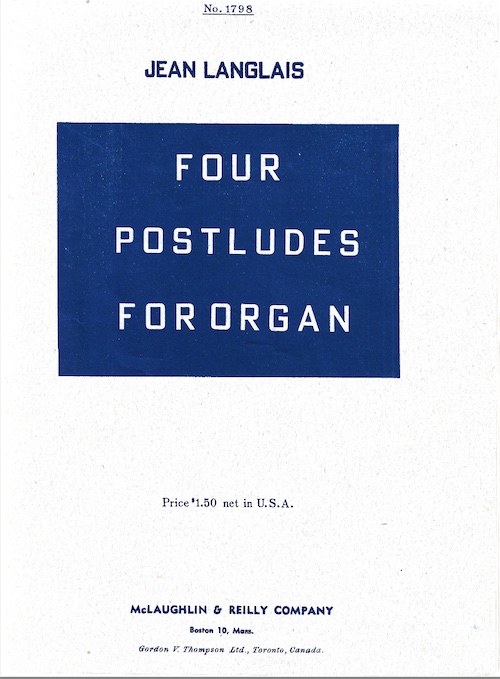
1951
Four Postludes for organ
Postlude 1 - Postlude 2 - Postlude 3 - Postlude 4
Published in 1951 by Mc Laughlin & Reilly, these Postludes have been
re engraved by the publisher Summy-Birchard in 1997. Both are now definitely out of print.
PDF available for free on demand to ml.langlais@wanadoo.fr
ERRORS IN THE ORIGINAL SCORE (1951)
p.14, bar 7, right hand, 2nd beat, the D should be #.
p.15, bar 12, left hand and pedal, 2nd chord, the F is # // p.15, bar 16, right hand, soprano G natural // p.15, bar 18, soprano first sixteen note, octave F natural.
p.16, bar 16, left hand, the chord is F natural-Bb-D natural- F natural.
Editions marie-louise langlais (Site web)
1952
Folkloric Suite (reprint)
1. Fugue sur "O Filii" - 2. Légende de Saint Nicolas - 3. Canzona - 4. Cantique - 5. Rhapsodie sur deux Noëls
Now available again on the website "sheetmusicplus.com"after a long period of permanent out of print.
Also available : "Canzona", n°3 of the Folkloric Suite, adapted for brass quartet and organ by Kenneth Danchik.
CORRECTED ERRORS in the printed score.
1. FUGUE SUR "O FiLii", tempo, quarter note= 107, not 92. / p.5, mes. 24, dotted quarter note=63.
2. LEGENDE DE SAINT NICOLAS: p.8, bar.1, d2 tied to beat 3.
3. CANTIQUE: p.15, mes. 21-22, left hand chords, add ties to C#-F#.
4. CANZONA: p.19, bar 6, registration change: Cromorne solo Choir and Cornet solo Récit. Off Sw/Choir.
p.20: Pedal: mes.11, 2nd beat, the notes are E-B, not E-G.
5. RHAPSODIE SUR DEUX NOELS: p.23, mes. 3, read "Add Sw. to Gt"; both hands play on Gt./ p.23, mes. 25, alto voice on C hoir, other voices on Gt.
p.25, mes. 8: left hand stays on Ch. unto the last mes. of this section/ mes. 9: no manual specified; should be played on Gt.
Editions Hal Leonard (Site web)
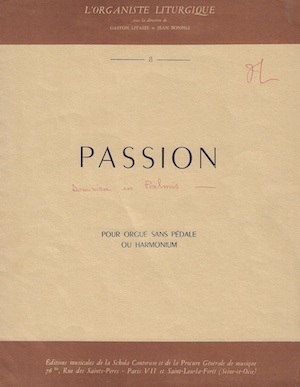
1954
Dominica in Palmis
in "Passion", collective book, n°8 of "L'Organiste liturgique" series.
Published first in 1954, then in 1980 by the Schola Cantorum editions together with "Incantation pour un Jour Saint" (p.2 to 11)
ERRORS in the EDITION, noted by Giorgio Benati:
p.9, bar 2,left hand, first note should be F#.
p.11, bar 1, right hand, the octave is G#-G# and not F#-G# // p.11, bar 3, right hand, 2nd beat, the C is # // p.11, bars 12-13-14, left hand is in G clef and not in F.
Editions stretta books (Site web)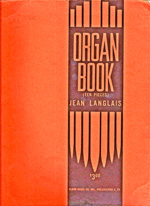
1956
Organ Book
I. Prelude - II. Pastoral Song - III. Choral in E minor - IV. Flutes - V. Musette - VI. Choral in F Major - VII. Scherzando - VIII. Andantino - IX. Epithalamium- X. Pasticcio
Published by Elkan-Vogel (USA) in 1957.
CORRECTED ERRORS in the PRINTED SCORE.
I - PRELUDE - p.1, bar 18, right hand, off the F, alto, 3rd beat, useless.
III - CHORAL IN E MINOR - p.8, bars 19-20, left hand, the B, whole note, is tied.
IV - FLUTES - p.9, last bar, left hand, the G is tied to top of p.10.
p.10, bar 6, right hand, third bichord must be C# and E natural, not C natural - E #.
V - MUSETTE - p.14, bar 1, right hand, beat 3, add natural before B. Same page, bar 2, left hand, 3rd beat, before B
VI - CHORAL in F MAJOR, p.19, bar 12, last note, E, should be eighth.
p.20, bar 1,, right hand, add tie from B to same note bar 2.
p.21, bar 9, right hand, remove dot from E eighth // p.21, bar 11, add tie to F.
p.22, bar 5, pedal, add tie to C.
VII - SCHERZANDO - p.23, bar 14, right hand, beat 3 should be D flat.5
p.24, bar 11, right hand, D should be eighth.
p.26, bar 5, pedal, add an eighth rest after G# and after C#.,
VIII - ANDANTINO - p.27, bars 1, 3, 9; p.28, bar 1; p 28, bar 1; p.29, bar 18; p.30, bar 8: change half note A to dotted half.
p.30, bar 10 and p.31 bar 1, right hand, should be a triplet of sixteenth.
IX - EPITHALAMIUM - p.35, bar 13, the B left hand should be tied with the preceding one.
X - PASTICCIO - Tempo, half note=86 and not quarter=116
p.38, last bar, 3rd beat, left hand, G, not F.
p.39, bar 16 to p.40, 3rd bar, both hands legato.Then staccato again p.40, bar 14.
Editions Theodore Presser (Site web)

1956
Triptyque
1. Melody - 2. Trio - 3. Final
Catalog number :NOVELLO - NOV 620001
Original score permanently out of print. But printed on demand (photocopy)to the publisher NOVELLO (GB)
ERRORS in the PUBLISHED SCORE
TRIO
Temp : Quarter note = 112, not 92.
p.8, bars 6-7, pedal has to be played one octave higher.
p.10, bar 2, right hand, second beat, the last F is natural. // p.10, bar 2, left hand, 4rth beat, the four last sixteen notes are E#- C# (and not
B) - G# - E natural.
p.12, bar 2, the pedal E - F has to be played one octave higher.
p.13, bar 1, the pedal D natural has to be played one octave lower.
p.15, bar 8, the right hand has to be played on the Swell.
Editions musicroom.com (Site web)
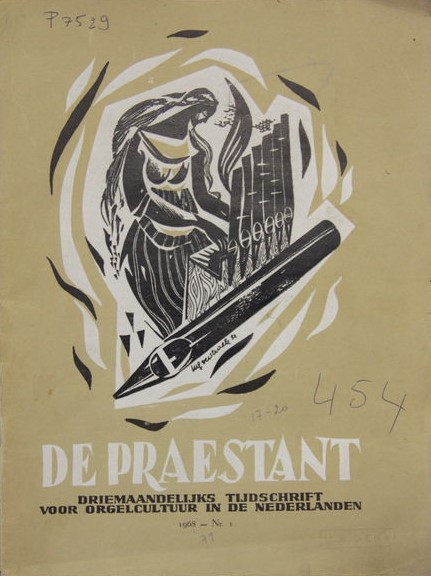
1956
Prélude à la messe "Orbis factor"
for organ ou harmonium
This Prelude has been composed by Jean Langlais in 1956. Dedicated to his colleague Flor Peeters, it has been published in october 1956 in the Belgium organ magazine "De Praestant".
Editions De Praestant (Site web)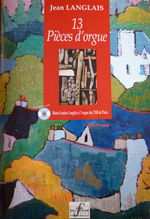
1956-1976
13 Pièces d'orgue (réédition)
Quatre Préludes (I à IV) - Petit Prélude sur deux thèmes grégoriens - Supplication - Six petites pièces (1.trio - 2.notes répétées - 3.legato - 4.staccato - 5.accords - 6.rythme) - Deo Gratias
- Cd included : ML Langlais plays these 13 Pieces on the Gerhard Grenzing organ of the Paris Regional Conservatory.
Definitely out of print organ pieces, rather easy, republished in one volume in 2007 at the occasion of Jean Langlais' birthday celebration.
ERRORS in the published score
p.1 (Quatre Préludes) bar 7, left hand, fourth chord is C natural- G natural as bar 5 of this page.
p.20 (Rythme), bar 8, right hand, last eighth note, chord B#-D#, not A#-C#.
Editions Delatour (Site web)
1957
Organ Pieces for the Mass : I. Office pour la Sainte Trinité (In Festo SS.Trinitatis) - II. Office pour la Sainte Famille (S.Familiae Jesu,Mariae,Joseph)
Ante Introitum - Post Offertorium - Post Communionem - Post Benedictionem
Published by Christophorus Verlag in 1959
Editions stretta books (Site web)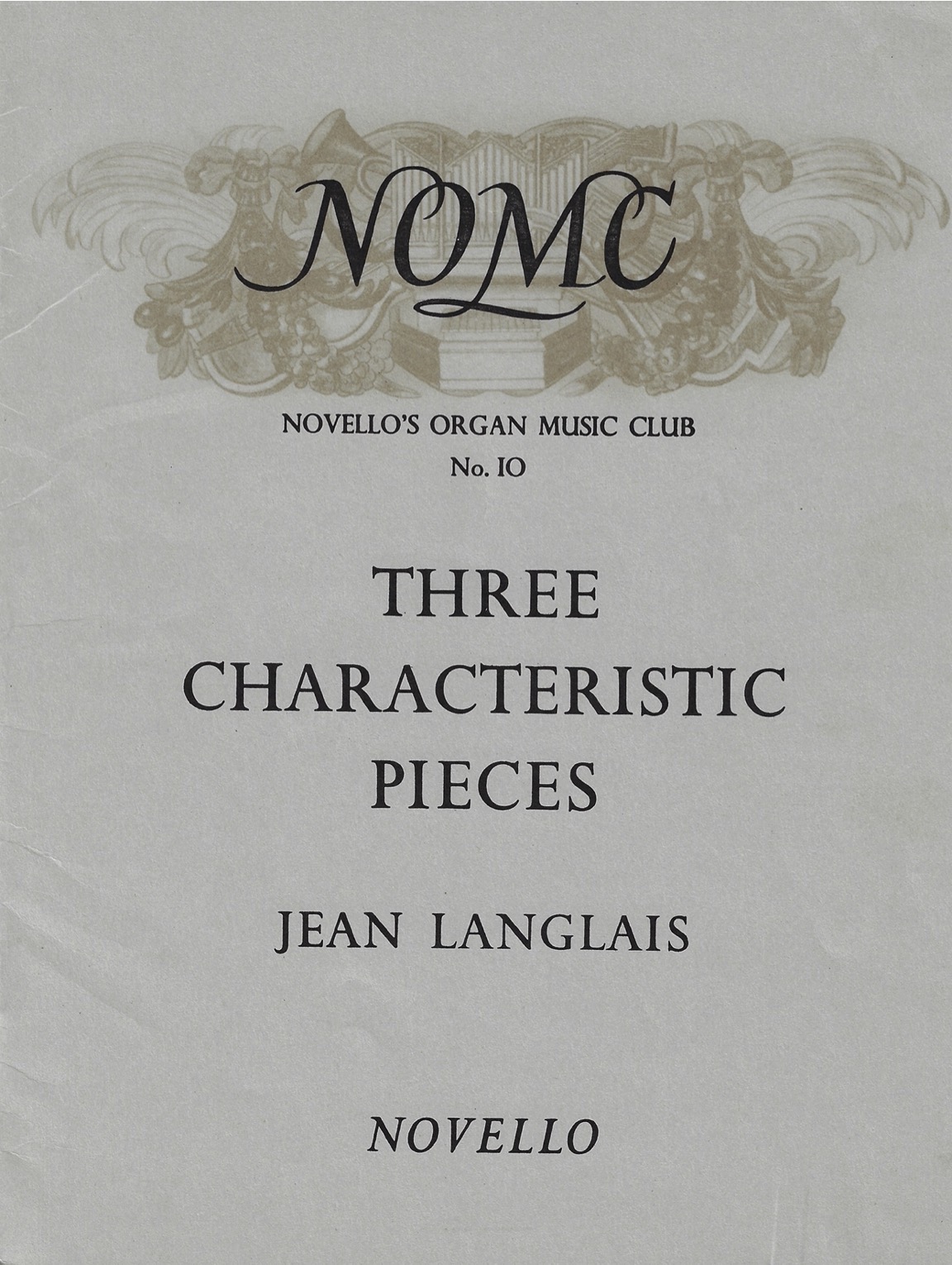
1957
Three Characteristic Pieces
1. Pastoral-Prelude - 2. Interlude - 3. Bells
The original edition (1957) being out of print, the publisher, Novello, send on demand a copy of it.
Catalog n°: NOV 570010.
Editions musicroom.com (Site web)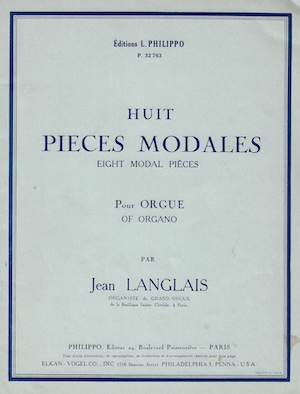
1957
Huit Pièces Modales
pour Orgue
N°1 Mode of D- N°2 Mode of A - N°3 Mode of E - N°4 Mode of B - N°5 Mode of F - N°6 Mode of C - N°7 Mode of G - N°8 Mode of G.
Published by Philippo in 1957.
Editions Henry Lemoine (Site web)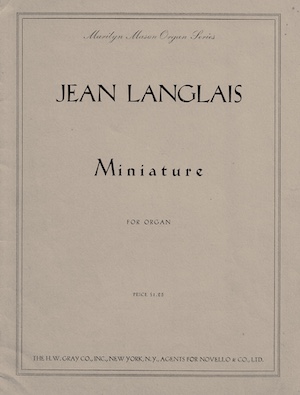
1958
Miniature
Marilyn Mason Music Library, vol. I
Published in 1959 by H.W.Gray (USA), in "Marilyn Mason organ Series"
CORRECTED ERRORS IN THE EDITION
p.4, bar 14-15:bar 14, left hand on the Ch, left hand bar 15 on Sw; there should be no break at manual changes.
p.5, m.1, right hand, fourth note in alto should be D (to preserve canon) // p.5, m.10, right hand, B should be a whole note.
Editions sheetmusicplus.com (Site web)
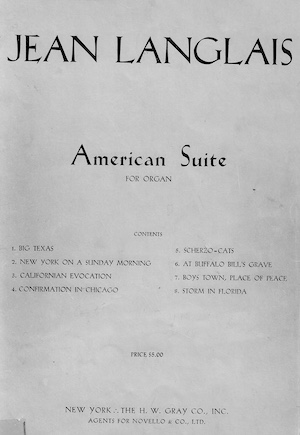
1959
American Suite
8 Pieces for organ
1. Big Texas - 2. New-York on a Sunday morning - 3. Californian Evocation - 4. Confirmation in Chicago - 5. Scherzo-Cats - 6. At Buffalo Bill's grave - 7. Boystown, place of peace - 8. Storm in Florida
DEFINITELY OUT OF PRINT
When H.W.Gray, the American publisher of this Suite in 1959, ceased definitively his activities, he gave back the copyright of this Suite to Jean Langlais, who decided to ask Universal Edition (Wien) to reprint 5 parts of this Suite under the title of "Troisième Symphonie", changing the titles for French titles: n°1 became Introduction, n°2 "Un Dimanche à New-York, n° 3, Cantabile, n°5, Intermezzo, and n° 8 Orage. and the composer shortened n° 2 and 8.
Later, in 1977, he asked the french publisher Combre to insert n° 6 and 7 in the book "Mosaïque" 2, unchanged but again with French titles ("Sure la tombe de Buffalo Bill" et "Boystown, lieu de paix")
Only n° 4, "Confirmation in Chicago" remained unpublished.
Editions Epuisé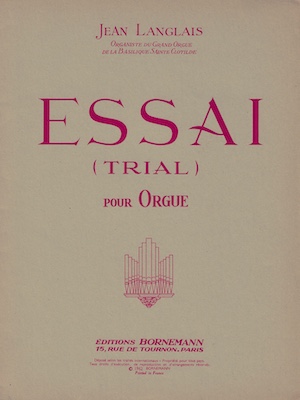
1961
Essai
(Trial) pour orgue
First commission by the Conservatoire de Paris to Jean Langlais for their 1961 session of the Organ class annual competition, published by Bornemann in 1962.
CORRECTED ERRORS in the PUBLISHED SCORE
p.3, bar 7, left hand, the last 4 eight notes should be the same than 4
bars before, in octave with the right hand.
p.4, bar 1, add whole note rest at the Pedal // p.4, 5-6, right hand, altos parts have to be tied // p.4, bars 10-11, the alto F is natural // p.4, bar 11, Pedal, the first A right foot should be dotes.
p.5, last bar, add a F key left hand, before the second group of notes.
p.6, bar 2, both hands, the second D of the eight notes group should be natural, same thing p. 6, bar 4// p.6, bar 9, add Pos. (Ch) right hand left part, like 3 bars later // p.6, bar 9, all the eight notes right hand have to be staccato, like 3 bars later // p.6, bar 9, alto, 6th eight note is a A#, not natural.
p.7, bar 3, left hand, last note is B, not G, in octave with right hand.
p.9, bar 10, the legato signs with the preceding bar are lacking on both hands.
Editions la flute de pan (Site web)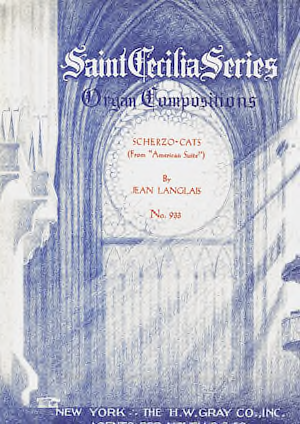
1961
Scherzo-Cats
N°5 of the "American Suite"
N°5 of the "American Suite", Scherzo-Cats has been printed alone in 1961 by H.W.Gray in the "Saint Cecilia Series" n°933. As the "American Suite", "Scherzo Cats" is out of print.
But the composer decided to include it, unchanged but with the new title of "Intermezzo" in his "Troisième Symphonie" published in 1980 by Universal editions (Wien).
Editions Universal (Site web)
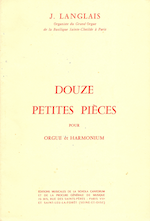
1962
Douze Petites Pièces
for organ and harmonium
I. 1er mode (finale ré) - II. 1er mode (finale mib) - III. 2nd mode (finale la) - IV. 3e mode (finale mi) - V. 4e mode (finale do#) - VI. 5e mode (finale fa) - VII. 6e mode (finale mib) - VIII. 7e mode (finale ré) - IX. 7e mode (finale mib)- X. 8e mode (finale mi) - Deux petites pièces dans le style médiéval (n°1 et 2)
Published by Schola Cantorum (France) in 1962.
Editions di Arezzo (Site web)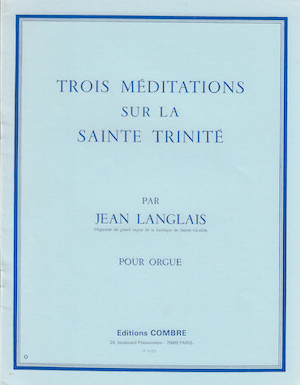
1962
Trois Méditations sur la Sainte Trinité
for organ
Première Personne: Le Père - Deuxième Personne: Le Fils - Troisième Personne: Le saint Esprit
Published by Philippo in 1962.
ERRORS in the PUBLISHED SCORE
PREMIERE PERSONNE: Le Père
Registration directions in English, switch Great and Choir
Choir : Oboe 8 or Cornet
Great; Foundations 8
DEUXIEME PERSONNE: Le Fils
p.5, bar 4, left hand, 4rth beat, add flat before small e.
TROISIEME PERSONNE: Le Saint Esprit
p.7 bar 1: tempo allegro=112 rather than 96.
p.9, bar 2, left hand, beat 3, chords staccato, as in bar 3.
p.10, bar 2, right hand, 4rth beat, chord D#-F#. accord Ré#-fa# // p.10, bar 4, right hand, 2nd beat, last A staccato as 3rd beat, the last D.
Editions Henry Lemoine (Site web)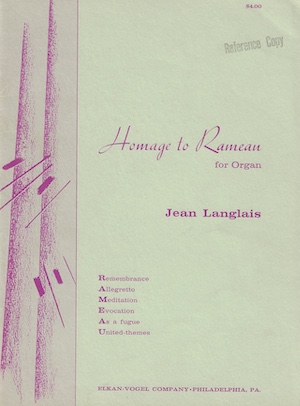
1962-1964
Homage to Rameau
6 Pieces for Organ
This book, commissioned by the Minister of Fine arts of France, André Malraux on the occasion of the 200 anniversary of the death of Rameau, has been published by Elkan-Vogel (USA) in 1965. But when this publisher retreated, he gave back the copyright of "Homage to Rameau" to Jean Langlais, who asked Bornemann to publish 3 excerpts of it: "Meditation", "Evocation" and "United Themes" under the title of "Ostinato"; later, in 1989, he asked Combre to publish the n° 2,"Allegretto", but he left beside n°1 and 5.
Editions Epuisé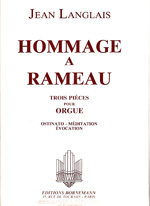
1962-1987
Hommage à Rameau
Ostinato - Meditation - Evocation
Comes from "Homage to Rameau", published by Elkan-Vogel (USA) in 1962. The publisher having sent him back the copyright, Jean Langlais kept 3 on the 6 original pieces, and gave them to Bornemann in 1987 (n°3-4-6). One other number (Allegretto) has been reprinted later (1988) in "Contrastes" by Combre..
Other website for this book : sheetmusicplus.com
Editions di Arezzo (Site web)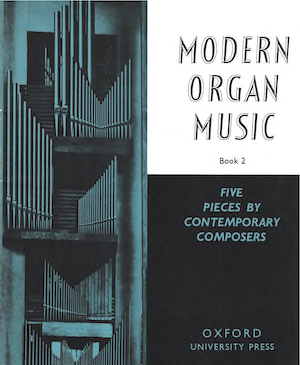
1963
Prelude on "Coronation"
in "Modern Organ Music", Book 2, "Five Pieces by contemporary composers"
Published with works by Kenneth Leighton (GB), Myron Roberts (USA), Anton Heiller (Autriche) and Georg Mushel (Russie)
PERMANENTLY OUT OF PRINT
Editions Oxford University Press (Site web)
1965
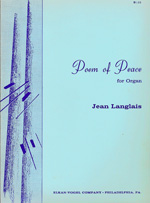
1966
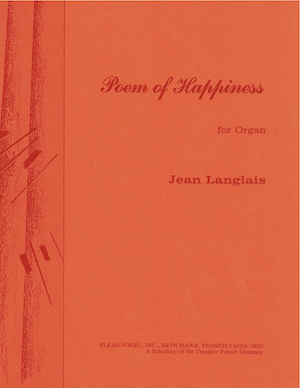
1966
Poem of Happiness
for organ
Published in 1967 by ElkanVogel (USA)
CORRECTED ERRORS IN THE SCORE
p.2, bar 9, left hand, last note, C# and not E.
p.6, pedal solo, first bar, two last notes, the rhythm is inverted: sixteen note-eight note and not the contrary.
Editions Theodore Presser (Site web)
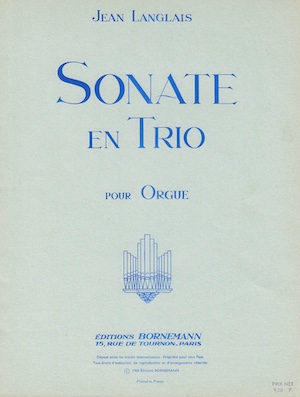
1967
Sonate en trio
pour Orgue
Conservatoire de Paris' second commission to Langlais for their final organ class exam in 1967. Published by Bornemann in 1968.
ERRORS in the PRINTED EDITION, list established with Bruno Mathieu's help.
ALLEGRO, 1rst movement
p.1, bar 5, left hand, third E is natural
p.4, bar 24, right hand, the last B is natural
p.5, bar 4, left hand, the F is natural // p.5, bar 5, right hand, both notes And G are detached // p.5, the bar 23, right hand, begins with E, not F#, like p.4, bar 10.
p.6, bar 8, left hand, the 3rd note, E, should be staccato // p.6, bar 12, right hand, the third note, F, is natural, not # // p.6, bar 12, left hand, second note is B natural, not G natural.
p.7, bar 19, right hand, the last note, C,, is natural.
FINAL, 3rd movement
p. 12, bar 15, left hand, the first E flat should be natural, as in the preceding bar.
Editions sheetmusicplus.com (Site web)
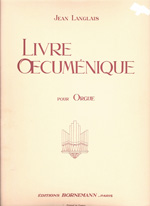
1968
Livre oecuménique
1.Sacris solemniis - 2.De Profundis - 3.Verbum supernum - 4.Eine Feste Burg - 5.Ave Maris stella - 6.Magnificat - 7.Pater Noster - 8.Notre Père - 9.Kyrie Orbis factor - 10.Kyrie, Dieu, Père Eternel - 11.Gloria Orbis factor - 12.Gloire à Dieu
When presenting this "Livre Oecuménique", the composer had a twofold aim: to write a work with a pedagogical purpose and to offer roman catholic organists and their protestant colleagues a group of short pieces of average difficulty which can be played during masses and during services as well. Six pieces have themes based on gregorian melodies, the six others being built upon choral themes used by JS Bach.
It goes without saying that roman catholic organists will have no scrupule in playing chorals' commentaries during services or recital. May our brothers separate in religion but united in art do the same with gregorian pieces".
Jean LANGLAIS (preface, the "Livre Oecuménique")
published by Bornemann (France) in 1968.
Other website to look at : sheetmusicplus.com
Editions di Arezzo (Site web)
1968
Adoration
in "Freiburger Orgelbuch"
Edited by Zürcher Organistenverband aux éditions Eulenburg (catalog Hinrichsen N° 2006d) (Switzerland) in 1970 in the book titled "ZeitgenÖssische Orgelmusik im Gottesdienst-IV (Contemporary organ music for liturgical use), this single piece is now included in the "Freiburger Orgelbuch" published by Carus (Germany). Reference: CV18075-00.
Editions Carus Verlag (Site web)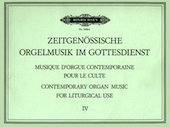
1968
Prélude dans le style ancien
Jean Langlais composed 2 short organ pieces, "Adoration" and "Prélude dans le style ancien", to be published in the organ book "Zeitggenössische Orgelmusik im Gottedienst" (Organ Music for Church Service) vol.4 (pieces 23 and 29), a collection of 36 original works by 20 different composers (PE 1102006D). "Prélude dans le style ancien is the 23h, and "Adoration" the 29th.
Later on, only "Adoration"has been reprint by editions Carus (Germany) in a book titled "Freiburg Orgelbuch".
Editions sheetmusicplus.com (Site web)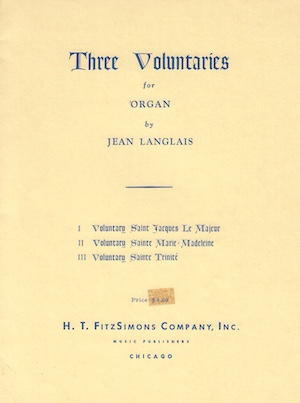
1969
Three Voluntaries
Three Voluntaries
I. Voluntary Saint Jacques Le Majeur
II. Voluntary Sainte Marie-Madeleine
III. Voluntary Sainte Trinité
Published first by H.T.FitzSimons in 1969, then by Fred Bock.
PERMANENTLY OUT OF PRINT
Editions Epuisé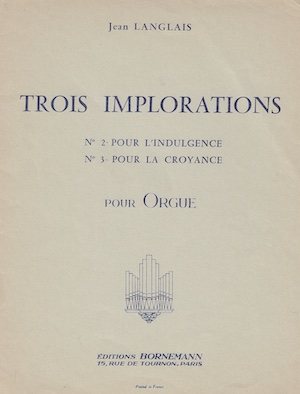
1970
Trois Implorations, volume 2
n°2 - Pour l'Indulgence - n°3 - Pour la Croyance
These two pieces have been composed a triptych along with "Imploration pour la Joie" published the same year by Bornemann (1970).
Editions di Arezzo (Site web)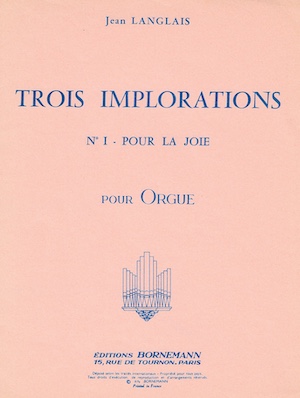
1970
Trois Implorations, first volume
n°1 - Pour la Joie
Third and last commission by the Conservatoire de Paris to Jean Langlais for de organ class competition of 1970.
Published byr Bornemann en 1970.
Editions di Arezzo (Site web)
1971
Cinq Chorals
1.Was uns die Erde Gutes spendet - 2.Nun singt ein neues Lied dem Herren - 3.Wie lieblich schön, Herr Zebaoth - 4.Gesegn uns, Herr - 5.Wir wollen singn ein Lobgesang
Published by Barenreiter (Germany) in 1975, in the book of "Choralvorspiele, Band IV).
Editions stretta books (Site web)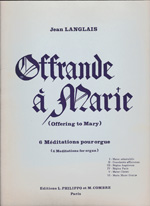
1971
Offrande à Marie
I. Mater admirabilis - II. Consolatrix afflictorum - III. Regina angelorum - IV.Regina pacis - V. Mater Christi. VI. Maria Mater gratiae
Published by Combre (France) in 1972.
ERRORS IN THE PUBLISHED SCORE, detected by Giorgio Benatti.
II - CONSOLATRIX AFFLICTORUM
p.9, bar 6, right hand, last chord, the B should be natural.
III - REGINA ANGELORUM
p.13, bar 10, bass part, left hand, last quarter : no A but G as in the right hand.
p.15, bar 11, alt part C# before the chord is lacking, should be like p.12, bar 10.
IV - REGINA PACIS
p.17, mes. 10, right hand, wrong knee : it should be an F key and not a G one.// p.17, mes. 14, same error, right hand: the kee should be a kee of G and not an F one.
VI - MARIA MATER GRATIAE
p.25 , the tempo indicated at the beginning of the allegro should be much faster : quarter note= 86
Editions Henry Lemoine (Site web)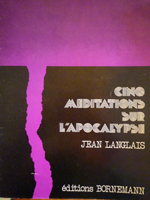
1973
Cinq Méditations sur l'Apocalypse
Celui qui a des oreilles, qu'il écoute - ll était, Il est et Il vient - Visions prophétiques - Oh oui, viens, Seigneur Jésus - La Cinquième trompette
Published by Bornemann (France) in 1974. Page 17 of this book has been modified in a reprint, following Jean Langlais indications; later Bornemann has been bought by Alphonse Leduc, in 1979, before Jean Langlais death.
1rst recording by Marie-Louise Jaquet-Langlais in 1975 at the Ste Clotilde organ under the direction of Jean Langlais. Recorded from the manuscript, before publication. Mp3 available for free on demand to ml.langlais@wanadoo.fr
Olivier Messiaen sent a long letter to Jean Langlais about this new work: "Paris, April 7, 1974 : My dear Friend,I received your Cinq Meditations for organ. Beautiful publication, and a dedication that is too kind! I just red the score with growing interest. You have magnificently understood this magnificent text. I especially appreciated the second piece with its repeated note, its "bacchian and dochmiae" rhythms, and its garlands on quintaton, flute 4' and tierce 1 3/5. The "Prophetics Visions" are varied as they should be, and the "Fifth Trumpet" is really very astonishing, very terrifying and very original...With all my admiration and affection, your old comrade : Olivier Messiaen"
CORRECTED ERRORS in the PUBLISHED SCORE. List established following the manuscript and compiled with help from Bruno Mathieu, Olivier Vernet and James Roman.
I - CELUI QUI A DES OREILLES, QU'IL ECOUTE. Manual indication is lacking. The entire movement should be played on the Récit.
p.2, mes.2, add crescendo to get to the f in mes.3 // p.2, mes.15, pedal, 3rd beat, F# and not F natural.
p.3, mes. 2, soprano, 6th note, the A is#, it is not natural.
2 - IL ETAIT, IL EST et IL VIENT, p.4, mes.2, the F should remain on the Récit for all this section.// p.4, add breaks in the melody, left hand, between mes. 6 and 7, and 15-16.
p.5, mes. 6, left hand, the C is a double sharp, not a sharp // p.5, mes. 16, tempo indication is lacking. It should be Quarter=112 //p.5, mes.20, left hand, 4th beat, the E should be one octave higher // p.5, mes. 21, 3rd beat, Pedal, the eighth should be A, not G# // p.5, mes. 22, 3rd beat, right hand, both A should be A#.
p.6, mes.15, right hand, third beat, the second chord should be D flat-G-C and not D natural-G-C // p.6, mes.16, right hand, 1rst beat, second chord, middle note should be A-natural.
p.7, mes.10, ignore R/Pos indication // p.7, mes. 10, right hand, 2nd beat G is an eighth note not a quarter, and the following rest comes just after, before the B flat 3rd beat, on the pedal A.
p.8 - Tempo same as beginning of the piece, Quarter = 92.
p.9, mes.7, left hand, the first E is natural (in the preceding measure, it was flat)
p.10- Registration, the lack of 8' foundations in Récit is intentional // p.10, mes. 14 - Add Pos/Ped // p.10, mes.16, right hand, the chord is D flat-F natural, not D#-F natural // p.10, mes 20-21, left hand, the chord is tied to the next one.
p.11, mes. 2, right hand, first chord should be D-natural, G-natural, B-flat, same as mes. 3, and second chord should be the same as in mes. 3, D#-G#-B natural..
p.12, mes. 8-9, soprano D last beat should be tied to the next measure, as the alto G# to the following one. // p.12, mes. 10-11, the B flat, alto and soprano, both hands, should be tied.
p. 15, mes.11, Final # before the last A in measure is not necessary.
3 - VISIONS PROPHETIQUES
p.17, mes. 8-9, in the first edition modified by a following print, there are octaves at the right hand in both measures and the chords A#-C#-D#-F# left hand have an extra note: A naturel. The version without octaves right hand of the first edition is much better. // p.17, at the end of mes. 10, add the indication "Fine" // p.17, mes.14, left hand, the chord is G#-D#-E natural, not E# // p.17, mes. 15, 16 and 19, : both hands should be played together, not one after the other as it is indicated in the first edition of 1974 and in the manuscript. The composer changed his mind and asked the publisher to print another version of this page, which has been done in a following print by Bornemann.
p.18, at the the Piu Lento, the metronomic marking can be faster, but this solo has to remain very expressive.
p.19, mes. 10, right hand, the last chord is F natural-B flat-D flat and not D natural..
p.20, the tempo at Piu Vivo should be Quarter = 126, not 116 //p.20, mes. 17-18, left hand, 2nd beat, should be D#-A#-D# and not C#-G#-C#.
p.21, mes. 2 to 5, the G whole note, left hand, is tied for these 4 measures.
p.22, mes.5, the 2 last notes in the left hand have to be switched, A#-D# instead of D#-A# // p.22, mes.6, left hand, the third eighth is D#, not D natural // p.22, mes. 16, the C#, left hand,1st beat, has to be a whole note, note a quarter.
p.23, mes.7, left hand chord should be, from the bottom up, B flat- C- E flat-G // p.23, mes.9, the left hand chord is G#-A#-B natural-D#; the sharp should be before the A and not before the B.
4 - OH OUI, VIENS SEIGNEUR JESUS
p.24, mes.17, pedal chord is F#-C#, not F natural-C natural.
p.25, mes .6, the last note of the soprano, F natural, should not be staccato as printed.
p.26, mes.2, the last chord right hand is A#-D# (and not natural)-F# // p.26, mes.3, left hand, the chord is F#-G#-A-C#, like in the following measure.// p.26, mes.10, first note of the soprano is A flat, not A natural.
5 - LA CINQUIEME TROMPETTE
p. 27, title in English, Fift should be Fifth // p.27, registration: in case of a big chamade existing on the organ, change the solo on the Récit, with trumpet 8, clarion 4 and mixtures, to a chamade stop alone // then, p.27, mes.18, the F natural has to be played alone on a chamade and the chord must be played on another manual.
p.31, mes.9, Pedal solo should be a C#, not a C natural // p.31, mes. 10, Pedal registration is missing: + flute 4+ Pos/Ped // p.31, last chord of the page, left hand, the B should be B flat.
p.33, ms.11-12 should be played one octave higher // p.33, last measure, last chord left hand should be E flat- A flat- C natural.
p.34, mes. 1 to 4, and mes. 17 to 20, if the tutti is too powerful, play the left hand on another manual and the right hand on the Great // p.34, mes. 13 to 16, add stops each measure to go to the Tutti //p.34: mes. 15, both hands are whole notes.
p.36, mes.1, left hand, the chord is E-A-C# and not F-A-C#.
p.37, mes.1, right hand, the 7th sixteenth note is D# and not F#.
p.41, mes. 8-9, play the right hand octave alta // p.41, mes. 9, F-C# staccato, like the bar before.
p.42, bar 4, left hand, last 16th note should be F natural // p.42, bar 11, 6th note should be B flat and not natural, like the following measure. Same thing page 43, bar 10; the 6th note is B flat and not natural , the same p.46, mes. 10.
p.45, bars 1, second and third triple eighth notes should be D-C# and not E-; same thing for the 18th and 19th notes in the same mes.
p.47, mes. 1, in the third group of 32nd notes, a "5" is missing // p.47, mes. 14-15, left hand, the chord should be F-A flat-B natural-E.
Editions di Arezzo (Site web)
1973
Suite Baroque
7 Pièces pour orgue
1. Plein jeu - 2. Trémolo en taille - 3. Dialogue - 4. Flûtes - 5. Dialogue entre le hautbois, le Bourdon et le Nazard - 6. Voix humaine - 7. Grand jeu
This neo-baroque Suite has been composed by Jean LANGLAIS at the occasion of the dedication, in 1973, of a newly reconstructed Silbermann organ at the St Jean protestant church in Mulhouse (France) by the Alsacian organ builder Alfred Kern.
It is why it looks like a pastiche of an old classical French organ, with some provocative titles, as "Tremolo en taille"..
Duration of this Suite, played live by Jean Langlais at the St Jean's Kern organ in Mulhouse : 15 mn.
ERRORS in the PUBLISHED SCORE
5 - DIALOGUES ENTRE LE HAUTBOIS, LE BOURDON ET LE NAZARD
p.9; line 4, bar 2, right hand, 2nd 16th note, B natural, 5th 16th note, B flat.
p.10, line 3, bars 2 and 3 left hand, second group of 16th notes are an octave up starting on G natural.
7 - GRAND JEU
p.14, last line, last bar, right hand, D and C quarter notes have to be tied.
p.15, mes. 9, left hand, last chord, the C of the chord is flat, like in the following bar.
Editions Henry Lemoine (Site web)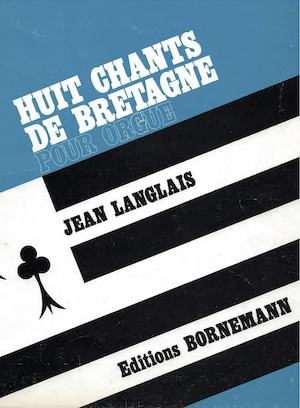
1974
pour orgue
1. Le Paradis (Paradise)- 2. Disons le chapelet (Let us say the rosary) - 3. Angelus - 4. Noël breton ( Brittany's Noël) - 5. Jesus mon sauveur béni (Jesus, my blessed Lord)- 6. Jésus nous dit de prier (Jesus tells us to pray)- 7. Aux Lys avec leurs feuilles argentées (to the fleurs-de-Lys with their silvery leaves)- 8. Pensez à l'Eternité (Meditate on eternity)
ERRORS IN THE PRINTED SCORE
n°1 - LE PARADIS
Add Pos./Ped at the beginning, Pedal no Flute 8
n°2 - DISONS LE CHAPELET
p.4, bar 24, left hand, 2nd beat, the C is natural.
p.5, bars 9 and 11, left hand, the E is natural.
n°3 - ANGELUS
p.8, bar 14, right hand, 1st beat, chord is A-D-E // p.8, bar 15, right hand, 1st beat chord is A-D-F.
p.9, bar 17, error at the pedal: it is Gr to Pedal off, not Sw to pedal off.
p.11, bar 18, right hand, 2nd beat, the F of the chord is natural // p.11, bar 23, left hand, the chord is F#-B flat-C- D#
n°4 - NOEL BRETON
p.12, Andante, tempo=96, not 72
p.13, bar 12, R: Hautbois+ Bourdon8 + Flûte 2
p.15, bar 6-7, Pedal, C connected
n°5,- JESUS, MON SAUVEUR BENI
p.20, bar 16, "A Tempo": mf
n°6 - JESUS NOUS DIT DE PRIER
p.27, bar 3, main droite, alto first beat: : G-F, not G-E
n°7 - AUX LYS AVEC LEURS FEUILLES ARGENTEES
p.29, bar 10, there should be the indication mf on the first beat
p.35, bar 12, soprano right hand, the B should be connected.
p.37, 10 to 12, soprano the F should be connected like left hand and pedal.
Editions di Arezzo (Site web)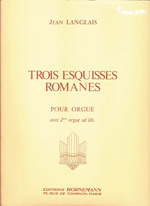
1975
Trois Esquisses Romanes for one or two organs ad libitum
Esquisse Romane n°1 (séquence Hac Clara Die. Xe siècle) - Esquisse Romane n°2 - Esquisse Romane n°3 (Jerusalem mirabilis. Appel à la croisade,1099)
Published by Bornemann (France) in 1976.
Editions di Arezzo (Site web)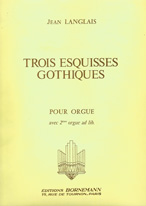
1975
Trois Esquisses Gothiques for one or two organs ad libitum
Esquisse Gothique n°1 (Veni Creator) - Esquisse Gothique n°2 (Virgo Dei genitrix) - Esquisse Gothique n°3 (Séquence pour la fête de la Dédicace)
Published by Bornemann (France) in 1976.
A Live recording of these Trois Esquisses Gothiques at Notre-Dame Cathedral in Paris, on November 12, 1977, by Jean Langlais (Grand Orgue) and Marie-Louise Langlais (Orgue de chœur) is available on YouTube.
CORRECTED ERRORS in the printed score.
ESQUISSE GOTHIQUE n°1: p.1, mes.15, left hand, the E whole note is flat.
p.2: mes. 8, left hand, 4rth beat, the G is natural, not sharp. / p.2, 13, right hand, the upper E is natural, not flat, like at the left hand.
p.4: mes. 18, left hand, 2nd beat, the F# is lacking, see the right hand.
p.5: mes.2, left hand, the sharp is before the A, not the B. / p.5, mes. 9, right hand, 4th beat, chord F-C, not G-C, like beat 2.
p.9, mes. 11, last beat, right hand, B flat is tied to the first beat of the following measure.
Editions di Arezzo (Site web)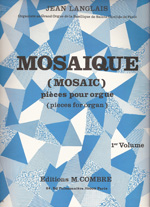
1975
Mosaïque 1
I. Stèle pour Gabriel Fauré - 2. Sur la tombe de Buffalo Bill - 3. Double fantaisie pour 2 organistes - 4. Boystown, lieu de paix
Published by Combre (France) in 1977.
Editions Henry Lemoine (Site web)
1976
Mosaïque 2
1. Gable - 2. Images - 3. Trio - 4. Complainte de PontKalleg - 5. Salve Regina
Published by Combre (France) in 1977.
ERRORS IN THE EDITION
3. TRIO
page 17 bar 9 , soprano part, the third sixteenth should be D#, not E#, like page 10 bar 24.
Editions Henry Lemoine (Site web)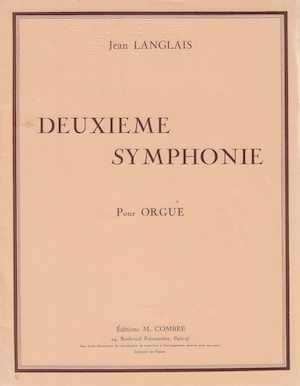
1976
Deuxième Symphonie pour orgue
"alla Webern"
I. Prélude -. II Lude - III. Interlude - IV. Postlude
Published by Combre in 1977
Editions Henry Lemoine (Site web)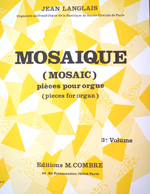
1977
Mosaïque 3
1. Parfum - 2. Lumière - 3. Printemps - 4. Thèmes - 5. Pax - 6. 2ème Fantaisie pour deux organistes
Published by Combre (France) in 1978.
Corrections of errors in the printed score
2 - PARFUM
p.10, add the G clef at the end of bar 5. as bars 6 and 7 are designed for it.
4 - THEMES
p.23, left hand, the G clef has to appear 3 bars before the end of the piece, not 2 bars
Editions Henry Lemoine (Site web)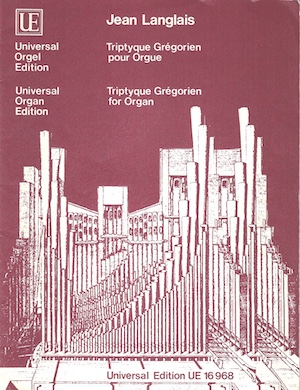
1978
Triptyque Grégorien
pour orgue
1. Rosa Mystica - 2. In Paradisum - 3. Alleluia
Editors: Martin Haselböck and ThomasDaniel Schlee - Universal Edition (UE n°16968)
Editions Universal (Site web)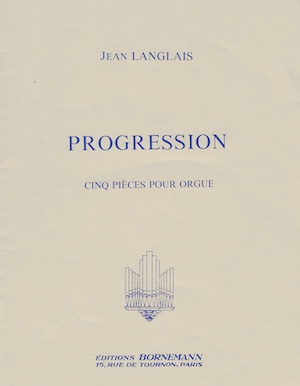
1978
Progression
Cinq Pièces pour orgue
1. Monodie - Duo - Larmes (Trio) - Offering - Fugue et continuo
Published by Bornemann in 1979.
ERRORS CORRECTED IN THE PUBLISHED SCORE
1 - MONODIE
p.3, bar 3, right hand, the last A is natural // p.3, bar 5, right hand, the 4th note, A, is natural.
2 - DUO
p.8, 2nd bar, both hands, the rhythm is sixteen note-eight note-eight note // p.8, bar 23 (last bar),right hand, legato sign on the last Gs, like before.
p.9, bar 3, left hand, third note A natural // p.9, bar 18, G clef right hand // p.9, bar 28, right hand, both F# staccato, like bar 10.
p.10, bar 2, both hands, second B is natural// p.10, bar 7, left hand, the F is # // p.10, bar 9, right hand, 3rd note, C, is natural // p.10, bar 10, right hand, the 5th note, C, is natural // p.10, bar 11, left hand, 5th note, C, is natural and 9th note is a A flat, not a B flat //
p.10, bar 16, the fermata should be on the G#, not on the C // p.10, bar 25, right hand, second G is natural.
3 - LARMES (trio)
p.11, bar 3-4, pedal, the F are tied // p.11, bar 4, left hand, E flat staccato // p.11, bar 11, eight notes staccato // p.11, bar 14, pedal, F tied with previous bar // p.11, bar 25, left hand, A flat.
p.12, bar 8, the 2 A are tied // p.12, bar 10, left hand, D whole note natural // bar 11, right hand, E natural.
p.13, bar 8, right hand, the B is natural // p.13, bar 19, right hand, E natural.
p.15, bar 5 : - flûtes 4,2
p.16, bar 3, right hand, first beat, B flat, D natural.
OFFERING
p.17, bar 9, right hand, 2nd chord C natural E //p. 17, bar 13, left hand, the last chord is in a sixteen note, not an eight note // p?17, bar 14, right hand, sixteen notes, not eight notes // p.17, 3rd bar, pedal, F#-C#, like before and after.
p.18, bar 8-9, the G soprano right hand is tied // p.18, bar 11, the tied sigh is lacking at the beginning of the bar on bass, tenors and alto parts // p.18, bar 16, G clef, not F clef, left hand // p.18, bar 19, a sixteen rest is lacking at the end of the bar, left hand // p.18, bars 19-20, chords detached on both hands, same bar 21 for the right hand.
p.19, bar 1, Left hand, the chord is tied with the previous one // p.19, bar 2, right hand, chord is C-G#-B natural // p.19, bar 7, left hand, G clef at the end of the bar //p.19, bar 9, pedal, chord E natural-B natural // p.19, bar 10, right hand, second chord C-E natural // p.19, bar 12, right hand, chord is E-A natural-D natural // p.19, bar 19, alto, 2nd eight note is C natural // p.19, bar 22, left hand, 3rd eight note is D natural.
p.20, bar 2, left hand, the D is natural // p.20, bar 6, right hand, Irst chord, the C is natural // p.20, bar 8, left hand, the D, 2nd beat, is natural // p.20, bar 9, right hand, the fourth sixteen note B is natural// p.20, bar 10, left hand, the first E is natural // p.20, bar 12, left hand, the G is natural.
p.21, bar 1-2, bass and tenor are tied, like pedal // p.21, bar 2, right hand, alto 6th sixteen note G, not A // p.21 bar 4, right hand, chord D-E flat-G, not D flat- E-G // p.21 bar 14, right hand, chord is C-G#-B natural // p.21 , bar 19, E natural // p.21, right hand is on the Swell.
5 - FUGUE ET CONTINUO
p.22, Allegro, Quarter note=80 // p.22, bar 3, right hand, all notes detached // p.22, bar 7, left hand, E flat, right hand, alto, E natural, right hand // p.22, bar 11, right hand soprano B natural // p.22, bars 12-13, right hand, a line is missing on the musical stave for 10 chords : A-C, B flat-D, C-E, etc.
p.23, bar 1, right hand, a note is missing on the third sixteen note; it should be B-E and note E alone, like on the first beat //p.23, yes.4, right hand, last B is natural // p.23, bar 6, left hand, the eight notes D and C are natural // p;23, bar 12, left hand chord A natural-C natural-D flat-F, and right hand, G and F natural // p.23, bar 15, pedal, first C is natural.
p.24, bar 2, pedal, first F is natural // p.24, bars 4-5, the legato signe has to be put on the middle note of the chord and not on the soprano // p.24, bar 15, pedal, the first E is natural.
p.25, bar 9, G# half note left hand is tied with the same bar 8.
p.27, bar 4, pedal, second sixteen note is B natural // p.27, bar 9, pedal, 2nd beat, A natural // p.27, bar 10 right hand, first beat G natural.
p.28, bar 4 and 5, eight rest lacking on the alto part, second part of the 1rst beat // p.28, bar 5, Only F and Ab tied with the following bar // p.28, bar 8, 6th sixteen note right hand C# and not C natural // p.28, bar 10, chord left hand is C#-E-F#-B natural // p.28, left hand, bar 11, chord is C flat-E flat- F natural-B flat // p.28, bar 1, pedal, 1rst note, G# has to be staccato.
Editions di Arezzo (Site web)

1979
Noëls avec variations
Noël I - Noël II."Il est né le Divin Enfant" - Noël III. "Ihr Hirten, erwacht"
Published by Universal (Wien) in 1981.
ERRATA IN THE PUBLISHED EDITION, found by Fausto Caporali
NOEL I
p.5, mes. 89, second note, soprano G# as in mes. 70 and 77
p.6, mes. 95, left hand, last eighth, upper part, D#, not C#
p.7, mes. 122-124, 1rst note left hand A#
p.7, mes.133, right hand, third note D natural
p.8 mes. 147, and later mes. 160, 164, 196, 209, 213, these low octaves at the pedal should be played one octave higher
p.13, mes. 210 : the first note right hand is a G, like in mes. 161 and 193
p.15, mes 256 : pedal, the third note is a E flat.
NOEL II
p.21, mes. 114 et mes. 130 p.23, left hand F#-E#-D#
p.21, mes. 115 et 131 p.23 : G natural- F natural-F#l-E flat
p.22, mes. 119-135, right hand, 4th note, Mi b
p.22, mes. 121-137, 1rst note right hand, A natural
p.23, mes. 124 and 128 right hand, 4rth note, E flat
NOEL III
p.32, mes. 130, right hand, second beat, upper note, not E but D
p.36, mes. 194, manuals have to be detached, like mes. 190
Editions Universal (Site web)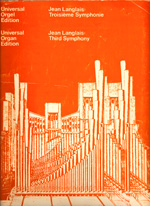
1979
Troisième Symphonie
1. Introduction - 2. Cantabile - 3. Intermezzo - 4. Un dimanche matin à New York - 5. Orage
Published first by Gray (USA) in 1959 as "American Suite" then reprint by Combre (France) for n°5-7 in "Mosaïque" 1, then by Universal (Wien) for n° 1-2-3-6-8) under the title : "Troisième Symphonie"
Editions Universal (Site web)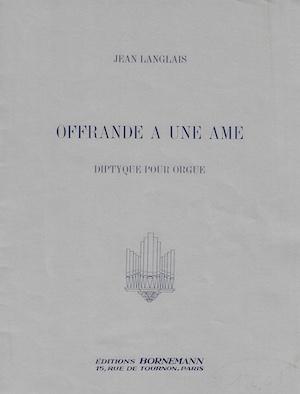
1979
Offrande à une âme
Diptyque pour orgue
1. Vers la Lumière - 2. Dans la Lumière
Published by Bornemann in 1979
Editions di Arezzo (Site web)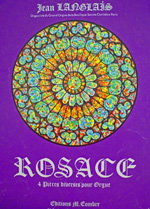
1980
Rosace
Pour une celebration - Introduction et marche - Croquis - Feux d'artifices
Published by Combre (France) in 1981.
Editions Henry Lemoine (Site web)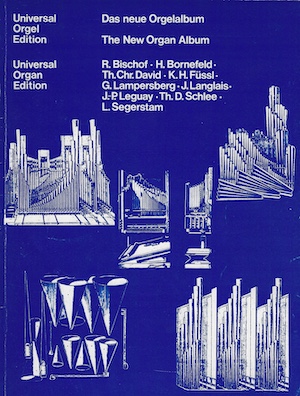
1981
Chant des bergers Prière des mages
in "Das neue Orgelalbum" (New Organ Album)
"Chant des bergers" (1929) and "Prière des mages" (1971)are two short and isolated pieces composed by Jean Langlais in 1929 and 1971.
They appear in this book with compositions for organ by R.Bischof, H.Bornefeld, Th.Ch.David, K.H.Füssl, G. Lampersberg- J.P.Leguay, Th.D.Schlee and L.Segerstam.
Editors: Martin Haselböck et Thomas Daniel Schlee.
Published by Universal (Wien) in 1982 (n°17174)
Editions Hal Leonard (Site web)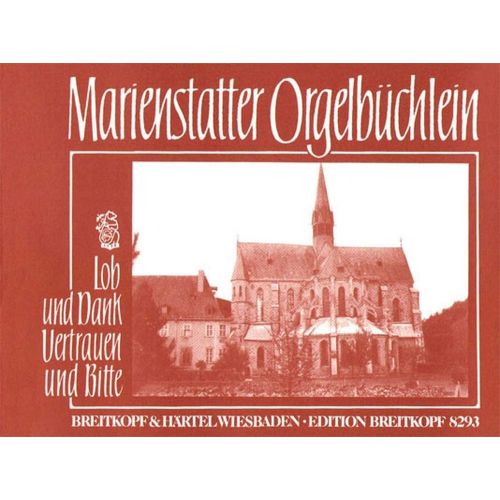
1981
Marienstatter Orgelbüchlein, vol. 3- Lob und Dank vertrauen und bitte
3 - "Erfreue dich, Himmel"
This Choral Prelude is intended to figure in the Marienstatter Orgelbüchlein, vol. 3, for both Catholic and Evangelic churches, following the idea of JS Bach "Orgelbüchlein" but in modern langage by various composers from different countries. This collection of 3 volumes (with 65 choral preludes) has been commissioned by Father Gabriel Hammer in 1981.
Editions stretta books (Site web)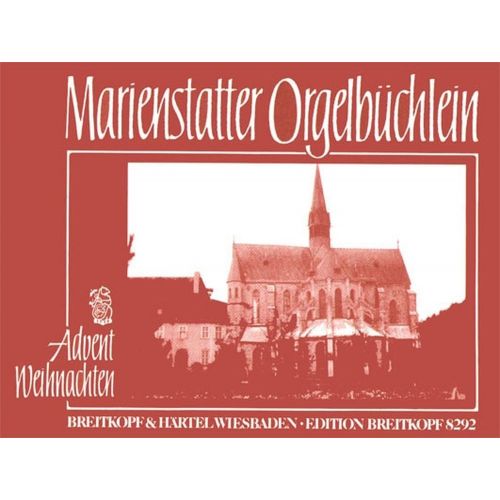
1981
Marienstatter Orgelbüchlein, vol. 1 - Advent
22 - "Lobpreiset all zu dieser Zeit" (Es ist gewisslich an der Zeit)
This choral prelude has been commissioned to Jean Langlais by Father Gabriel Hammerin 1981 to figure in the volume 1 of the Marienstatter Orgelbüchlein, a set of 3 volumes with a collection of 65 choral preludes composed by various composers of the 20th century for both Catholic and Evangelical churches.
Editions stretta books (Site web)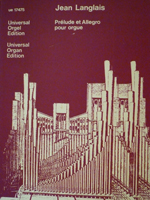
1982
Prélude et allegro
Prélude - Allegro
Published by Universal (Wien) in 1985.
Editions Universal (Site web)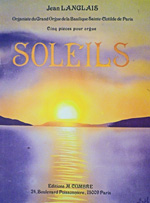
1983
Soleils
Matin - Midi - Soir - Etoiles - France
Published by Combre (France) in 1983.
Editions Henry Lemoine (Site web)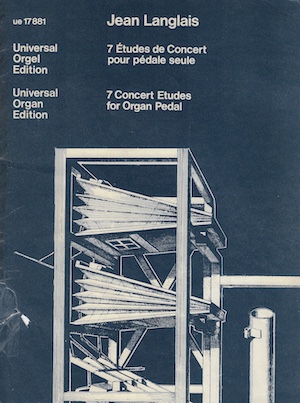
1983
7 Etudes de Concert pour pédale solo
to Jean Guillou
1.Chromatique - II. Contrepoint I - III. Alternances - IV. Contrepoint 2 -
V. Staccato - VI. Trilles - VII. Alleluia.
Edition Martin Haselböck and Thomas Daniel Schlee. Published by Universal Edition (Wien) - N° 17881
Editions Universal (Site web)
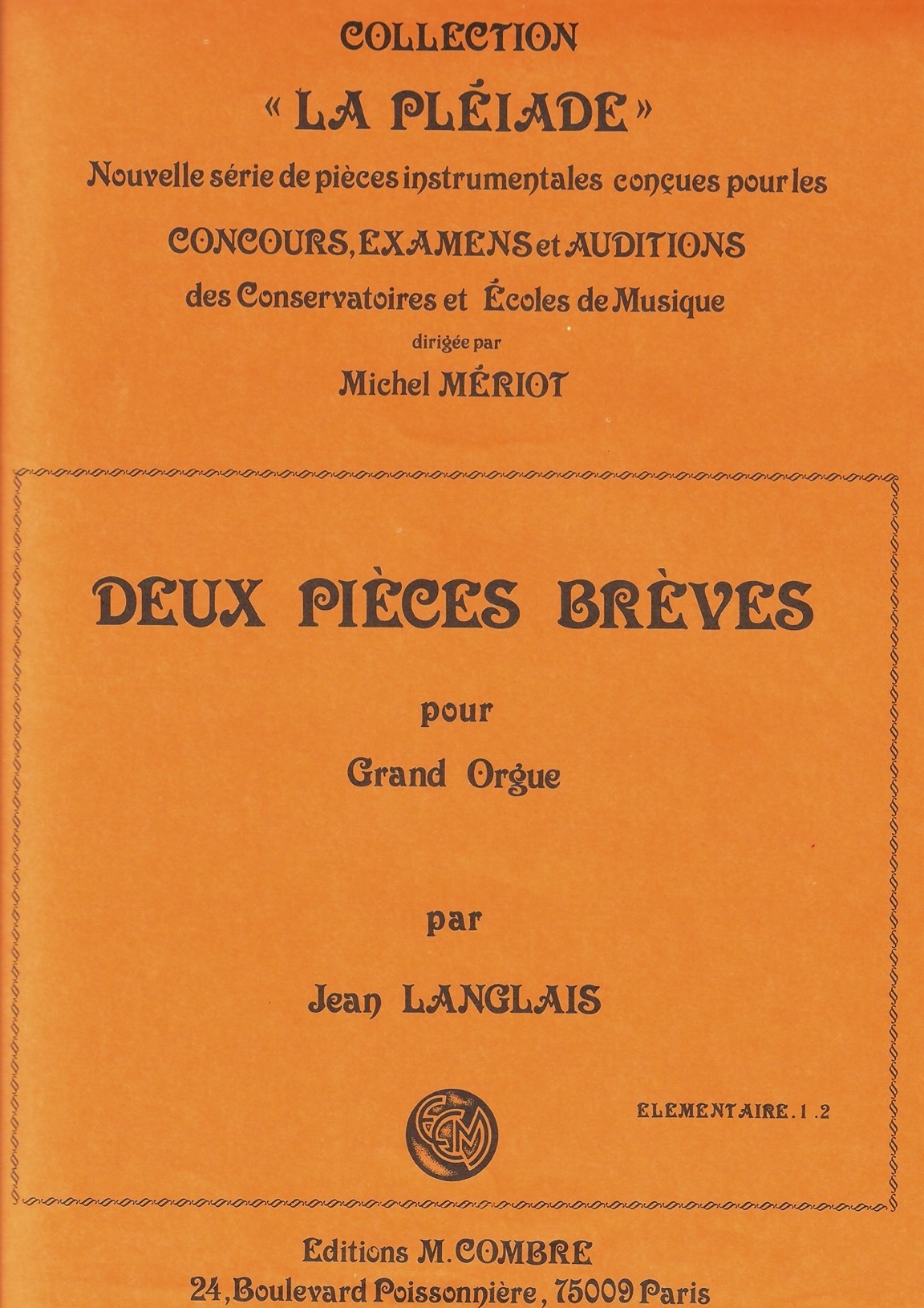
1983
Deux Pièces brèves
Brève 1 - Brève 2
Published by Combre in 1983 at the intention of music schools, level Elementary.
ERREURS DANS LA PARTITION IMPRIMEE
BREVE 2
Bar 16: right hand G# on the 3rd sixteen note.
Editions Henry Lemoine (Site web)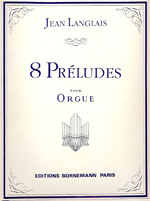
1984
Huit Préludes
n°1. Une voix - n°2. Duo - n°3. Trio - n°4. 4 voix - n°5. 5 voix - n°6. 6 voix - n°7. 7 voix - n°8. 8 voix: 3ème Fantaisie pour 2 organistes
Published by Bornemann (France) in 1984.
Editions di Arezzo (Site web)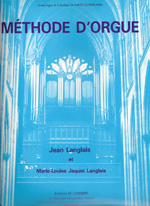
1984
Méthode d'orgue (with Marie-Louise Jaquet-Langlais), a practical and progressive method with a survey of improvisation.
Introduction - Etude du pédalier - Notions complémentaires relatives à l'orgue - Aperçu sur l'improvisation
Published by Combre (France) in 1984.
50 pages; text in French, English, German
This Method is mostly written to study pedal technique (p.4-41)as explain the authors in the Introduction, p.1 :
"In this method, we have voluntarily not approached certain problems about organ technique (phrasing, ornamentation, registration, fingering old and new). All these purposes being conterversial, we prefer to trust the wiseness and experience of responsible teachers".
Editions Henry Lemoine (Site web)
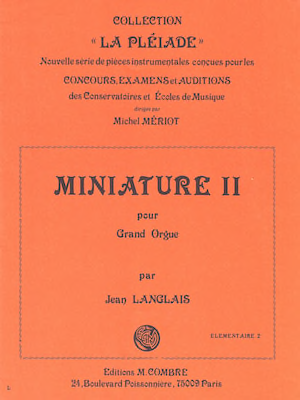
1984
Miniature II
pour Grand Orgue (Elémentary 1)
in Collection "La Pléiade". New series of instrumental works conceived for Music Schools.
Published in 1984 by Combre.
Editions Henry Lemoine (Site web)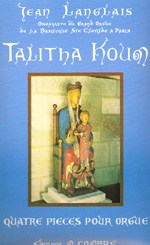
1985
Talitha Koum (Resurrection)
Salve Regina - Regina caeli (O clemens - O Pia - O dulcis) - Messe X : aux fêtes de la Sainte-Vierge - 1,7,8 (alleluia)
Published by Combre (France) in 1985.
Editions Henry Lemoine (Site web)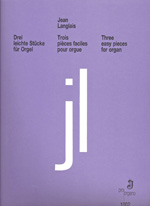
1985
Trois Pièces faciles (Drei liche Stücke)
Libre - Récitatif - Allegro
Published by Pro Organo (Germany) in 1986.
Editions stretta books (Site web)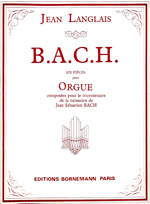
1985
ns la partition imprimee
n°1 to 6
Published by Bornemann (France) in 1985.
ERRORS IN THE PUBLISHED SCORE
p.3, bar 11, right hand, second chord must be G#-C# like in the following 3 measures.
Editions di Arezzo (Site web)
1986
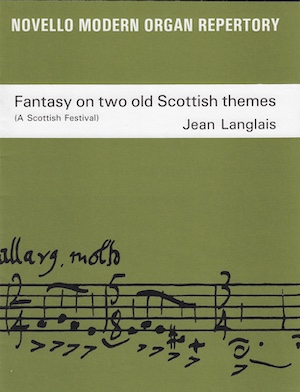
1986
Fantasy on Two old Scottish themes
A Scottish Festival
Commissioned by Marjorie Bruce-Morgan. Based on the airs "Island Spinning Song" and "Lewis Bridal Song". First performance given by Marjorie Bruce-Morgan on June 10, 1987 in St. Stephen's Church, Edinburgh during "Edinburgh Organ week" to celebrate Jean Langlais' 80th birthday.
Editions Hal Leonard (Site web)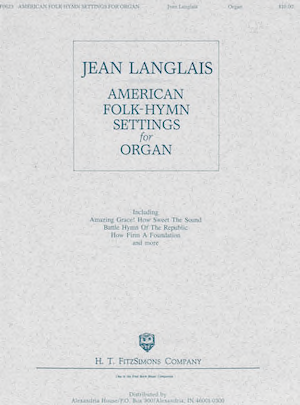
1986
American Folk-Hymn Settings
for Organ
Amazing Grace! - Battle Hymn of the Republic - How Firm a Foundation - There is a Fountain Filled with Blood - When I Can Read My Title Clear - On Jordan's Stormy Banks I Stand
Book commissioned to Jean Langlais by the American publisher Fred Bock on different American Folk Hymns selected by him.
Editions Hal Leonard (Site web)
1986
In Memoriam
"T the memory of my master, CHARLES TOURNEMIRE"
Published byr Combre in 1986
Editions Henry Lemoine (Site web)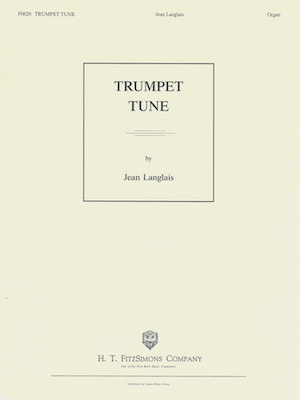
1987
Trumpet Tune
for organ
Piece commissioned by Jonathan Dimmock, organist at St John the Divine church in New-York City, to celebrate the famous trompette en chamade of this church.
ERRORS IN THE PRINTED SCORE
p.6, mes.6, right hand, the last chord is a eight note, not a quarter.
Editions Fred Bock (Site web)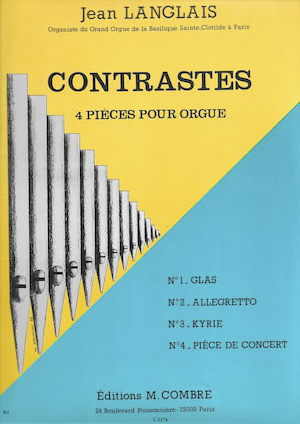
1988
Contrastes
4 Pièces pour orgue: 1. Glas - 2. Allegretto - 3. Kyrie - 4. Pièce de concert
Editions Henry Lemoine (Site web)
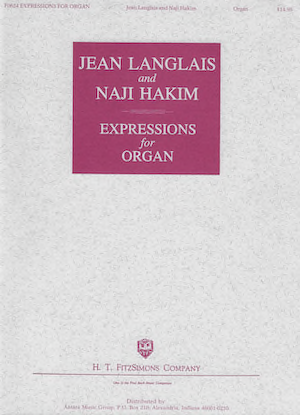
1988
Expressions
30 pieces without pedal by Jean Langlais and Naji Hakim
Pieces n° 1 to 15 by Jean Langlais, and n°16 to 30 by Naji Hakim, commissioned by Fred Bock to Jean Langlais who decided to compose the first part and give the second part to Naji Hakim.
Published by Fred Bock (HT Fitzsimons) - FO624
ERRORS IN THE PUBLISHED SCORE
p.9, bar 14: left hand, mes. 2, 1rst beat, last not should be a F#, not a G#.
p.12, bar 14 : right hand both F# staccato
p.19, bar 2 : right hand, in the chord, G natural, not B natural.
p.27, bar 14, left hand, tenor, the G, 3rd beat, should be natural.
Editions Hal Leonard (Site web)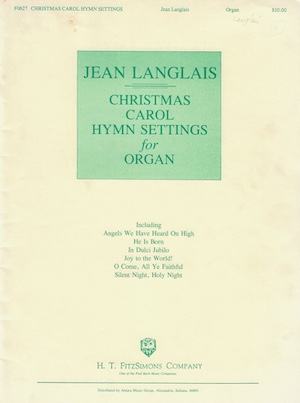
1988
Christmas Carol Hymn settings
for organ
O COME, ALL YE FAITHFUL - ANGELS WE HAVE HEARD ON HIGH - IN DULCI JUBILO - JOY TO THE WORLD - HE IS BORN - SILENT NIGHT, HOLY NIGHT
Commissioned by the publisher Fred Bock on Christmas themes he selected - H.T.FitzSimons Company (Fred Bock F0627)
Editions Hal Leonard (Site web)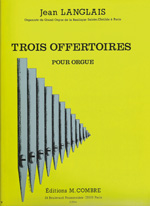
1990
Trois Offertoires
I - II - III
Published by Combre (France) in 1991.
Editions Henry Lemoine (Site web)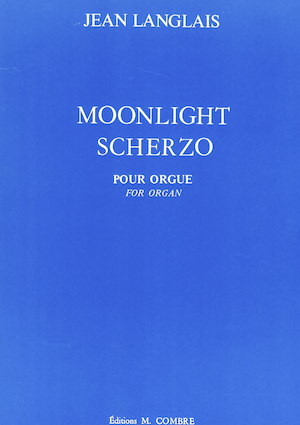
1990
Moonlight Scherzo
for organ
Published by Combre in 1990. Based on the popular song "Au clair de la lune", "Moonlight Scherzo" is dedicated to Colette Geneste, who directed the French publication Combre and was very dedicated to Jean Langlais' organ works. It is a testimony of his friendship to her.
ERRORS IN TRHE PUBLISHED WORK
p.3, bar 6, left hand, last chord should be C#-E#-G# as in bar 4.
p.9, bar 8, left hand, the F in the chord is natural.
p.10, bar 2, right hand, last quarter, the second sixteen should be E flat, not natural // p.10, bar 5, left hand, the second part of the measure (4 eight notes) should be similar as the first part (F natural, 2nd eight note, and F# 4rth eight note) // p.10, bar 8, right hand, second chord is C natural-F natural.
Editions Henry Lemoine (Site web)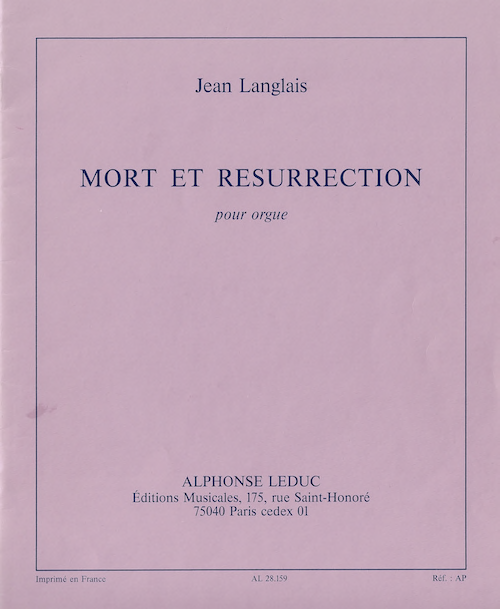
1990
Mort et Résurrection
for organ
Work ordered in 1990, to honor the memory of Jean Alain, killed in 1940. Published by Leduc in 1990.
ERRORS in the PRINTED EDITION
1 - MORT:
p.2, bars 17-18: right hand, the A# has to be tied between the 2 bars. // p.2, left hand, bars 23-24, both Cs have to be natural, // p.2, left hand, all the Ds are tied.
p.3, bar 7, the tempo is 50 for the quarter note // p.3, bar 129, the tempo is 72 for the quarter note, pie vivo.
p.4, bar 8, right hand, there is no F clef // p.4, bar 8, right hand, the value of the A# is wrong; add a 8 note tied.
p.5, bar 1, right hand there is a G key, not a F key, and the D# is tied to the following measure // p.5, bar 16, the G key is lacking right hand.
p.6, bar 6, pedal, - Gr/Ped.
p.7, bar 1, add Gr/Ped // p.7, bar 1, both hands staccato, like the preceding bar, p. 6. // p.7, bar 3, the key left hand is G, not F. // p.7, bat 4, pedal, the last double notes are A and E natural // p.7, bar 10, right hand, the key is F, not G.
p.8, 2nd bar, both hands on the Great // p.8, bar 3, right hand, the B, 2nd note, is flat. // p.8, bar 15, left hand, 2nd beat, the B (bass) is natural.
p.9, first bar, both hands are on the Swell. // p.9, bar 4, add the sign FF both hands.// p.9, bar 6, right hand, the 4th 16 note soprano is a F natural. // p.9, bar 9, both hands are on the Great.// p.9, bar 15, left hand, last chord is CV natural- F natural- B flat. // p. 9, last bar, right hand, first chord, the # should be placed before the C, not before the A.
p.11, bar 5, add a G clad at the end of the bar, right hand.
p.11, bar 4, F key
, not G.
p.13, bar 9, pedal, the rhythm is wrong on the 4th note, it should be a 16 note, not an eighth.// p.13, bar 10, pedal, wrong rythm too,
on the second beat, C and E are 16 notes, tied to a 8th note.
2 - RESURRECTION
p.14, bar 9, left hand, 2nd beat, the chord is E- F#- A -C#.
p.15, bar 2, left hand, the # is on the F, not on the E // p.16, bar 6 , - Gr/Ped // p.15, bar 7, add Gr/Ped.// p.15, bar 10, add "Pie vivo", quarter note= 80.
p.16, bar 1, off Montre 8 Great // p.16, bar 1, Tempo primo = 76 // p.16, 2nd bar, right hand, first chord, the C should be natural. // p.16, bar 3, pedal, both notes are natural (F-C) // p.16, bar 4, right hand , the A should be natural, like in the pedal. // p.16, bar 6, right hand, the D is natural // p.16, bar 13, right hand first chord, all notes natural (D-G-B), like the following bar // p.16, bar 15, it is not 6/4 but 9/4 // p.16, bar 15, left hand, the F is natural in the chord and it has to be tied all the measure // p.16, last bar, pedal, the G is natural.
Editions Leduc (Site web)
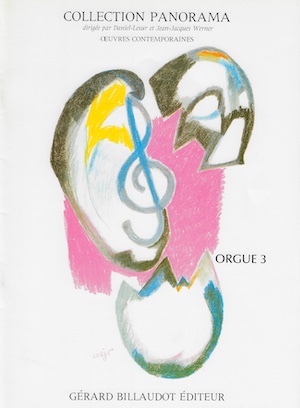
1990
Trio
in Collection Panorama, directed by Daniel-Lesur and Jean-Jacques Werner - Contemporary Organ works 3
3e recueil d'oeuvres pour orgue - medium difficulty
Editions Billaudot (Site web)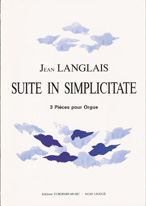
1991
Plein jeu à la Française - Virgo Maria - Cum Jubilo
Published by Europart (France) in 1991.
Editions di Arezzo (Site web)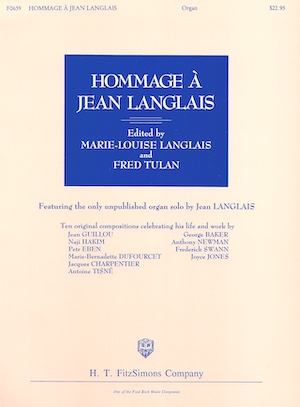
1996
Hommage à Jean Langlais, a collective book
Featuring the only unpublished organ solo by Jean Langlais
Collective book edited by Marie-Louise Langlais and Fred Tulan, in homage to Jean Langlais.The first piece, "Prelude grégorien" is an unpublished work by Jean Langlais, dedicated to his pupil and friend George C. Baker. Then, the other pieces have been composed by
George C. Baker, Jacques Charpentier,Marie-Bernadette Dufourcet, Petr Eben, Jean Guillou, Naji Hakim, Joyce Jones, Anthony Newman, Frederick Swann and Antoine Tisné,
Editions Hal Leonard (Site web)